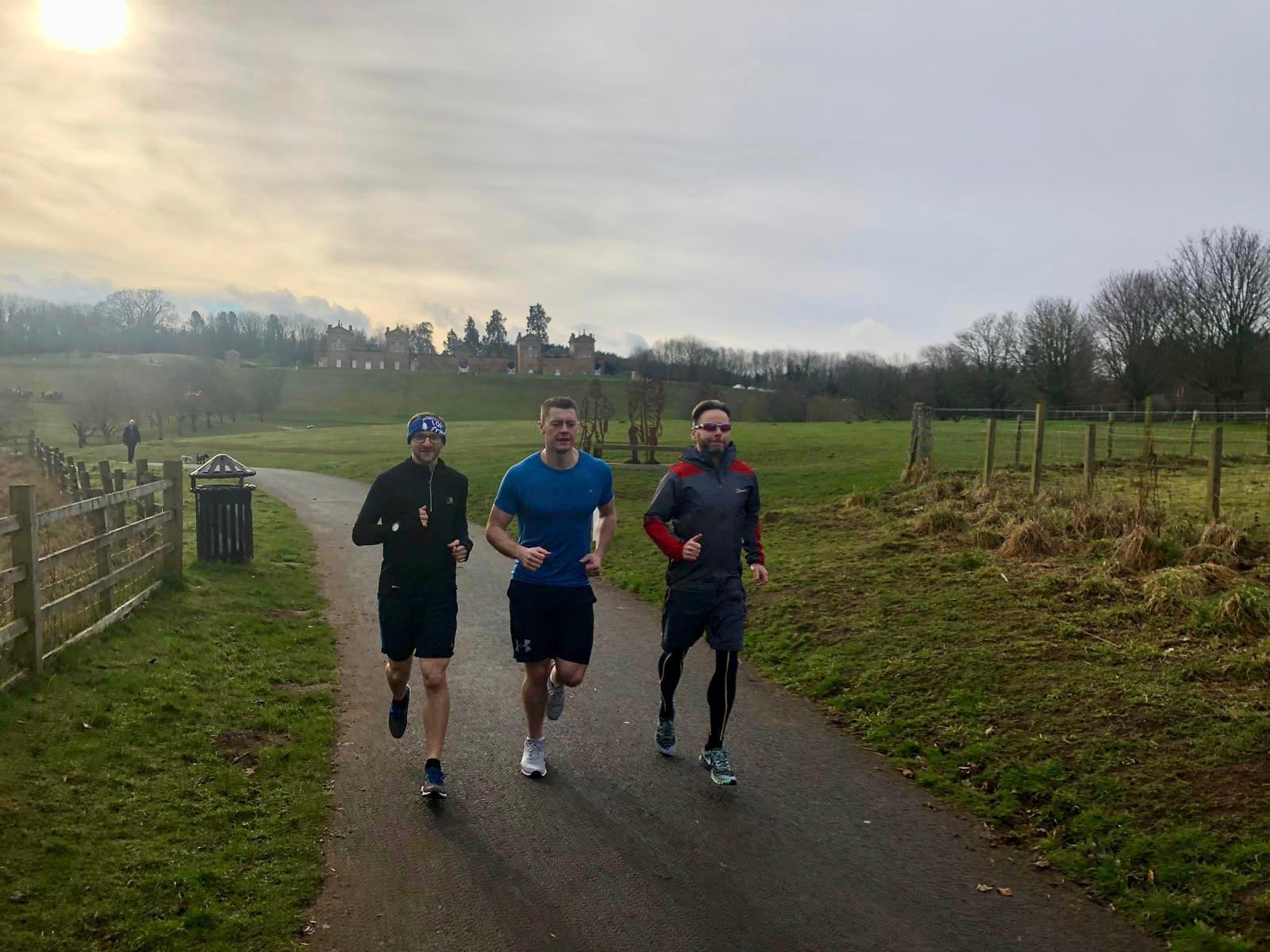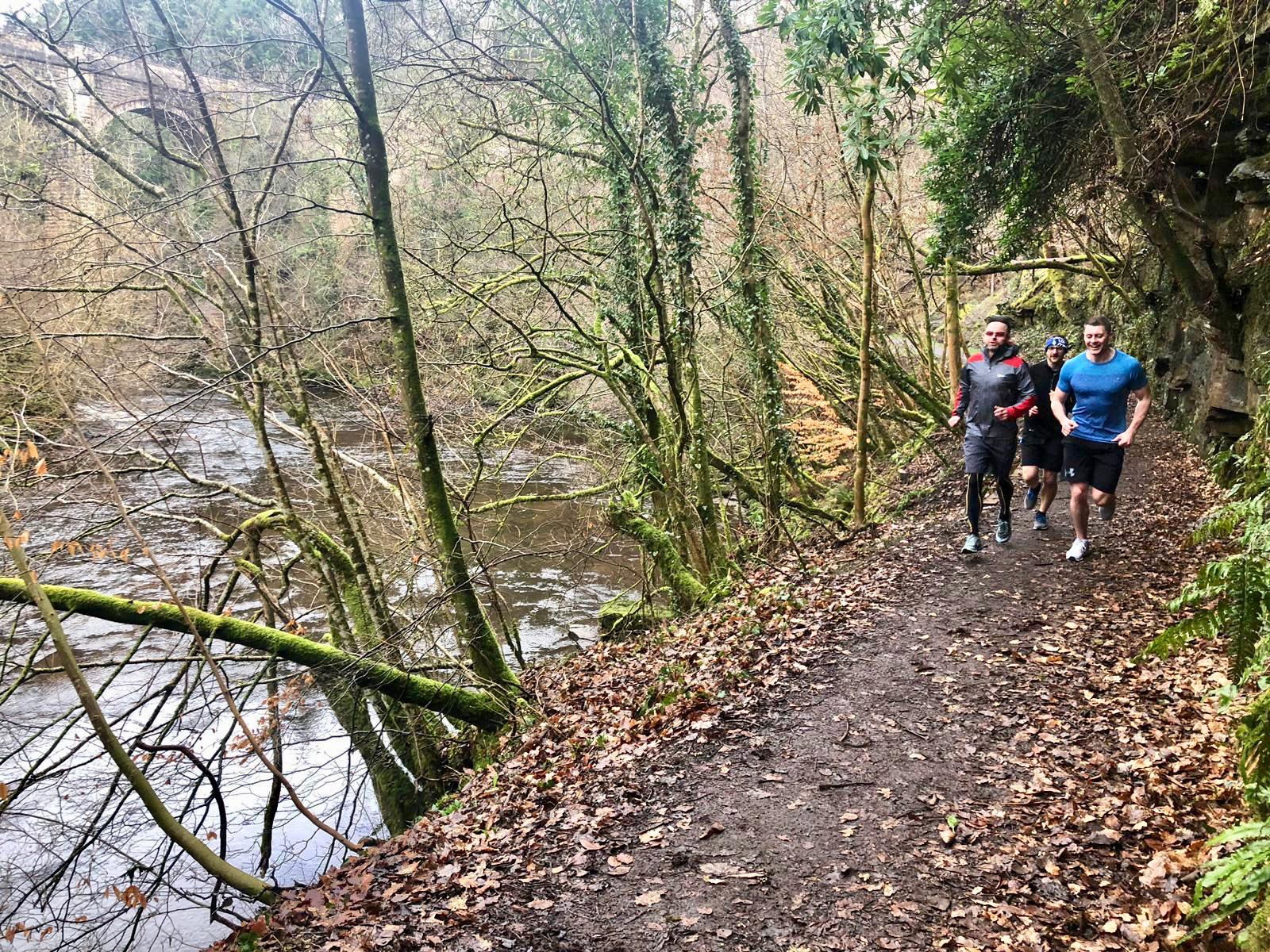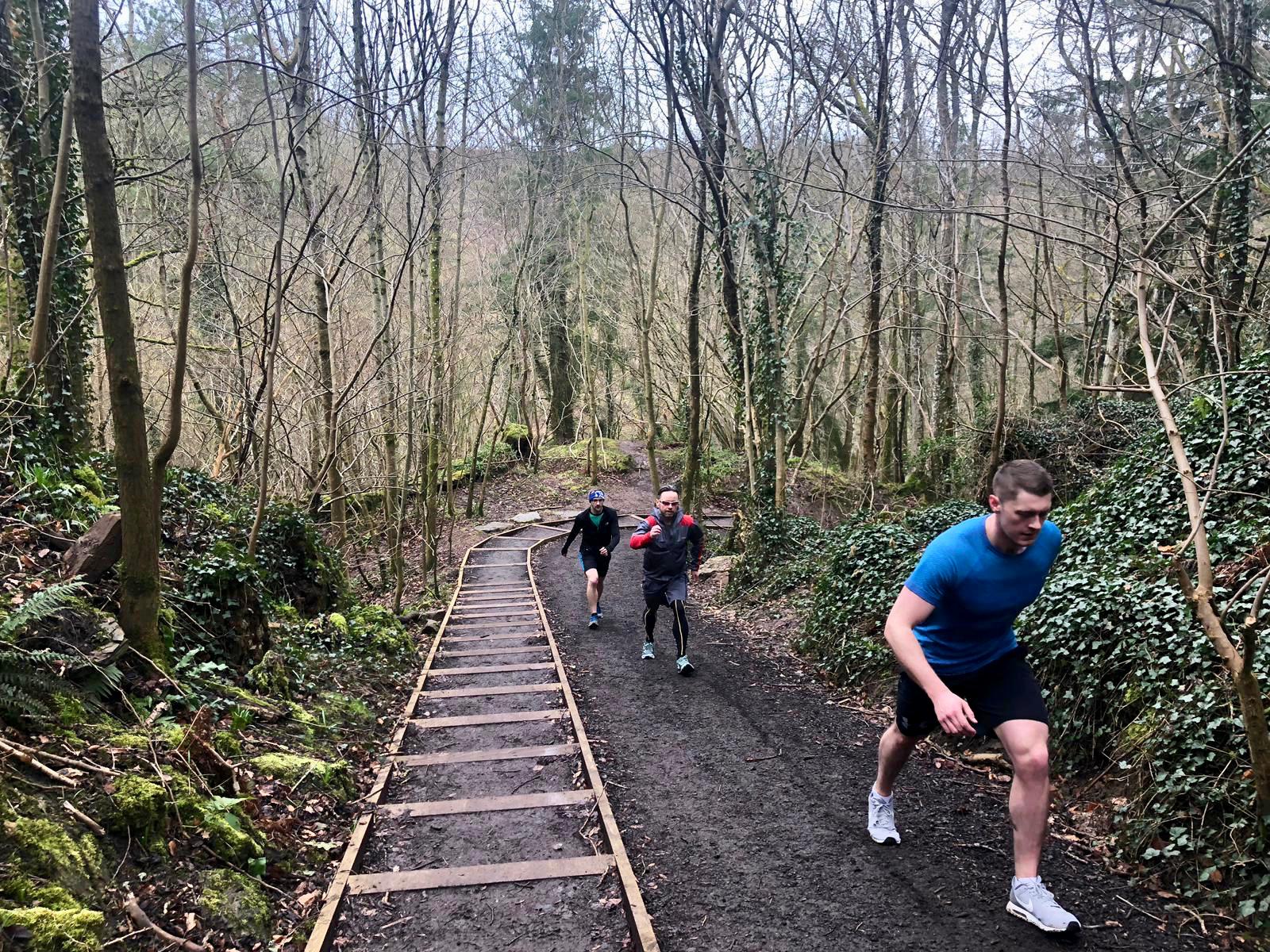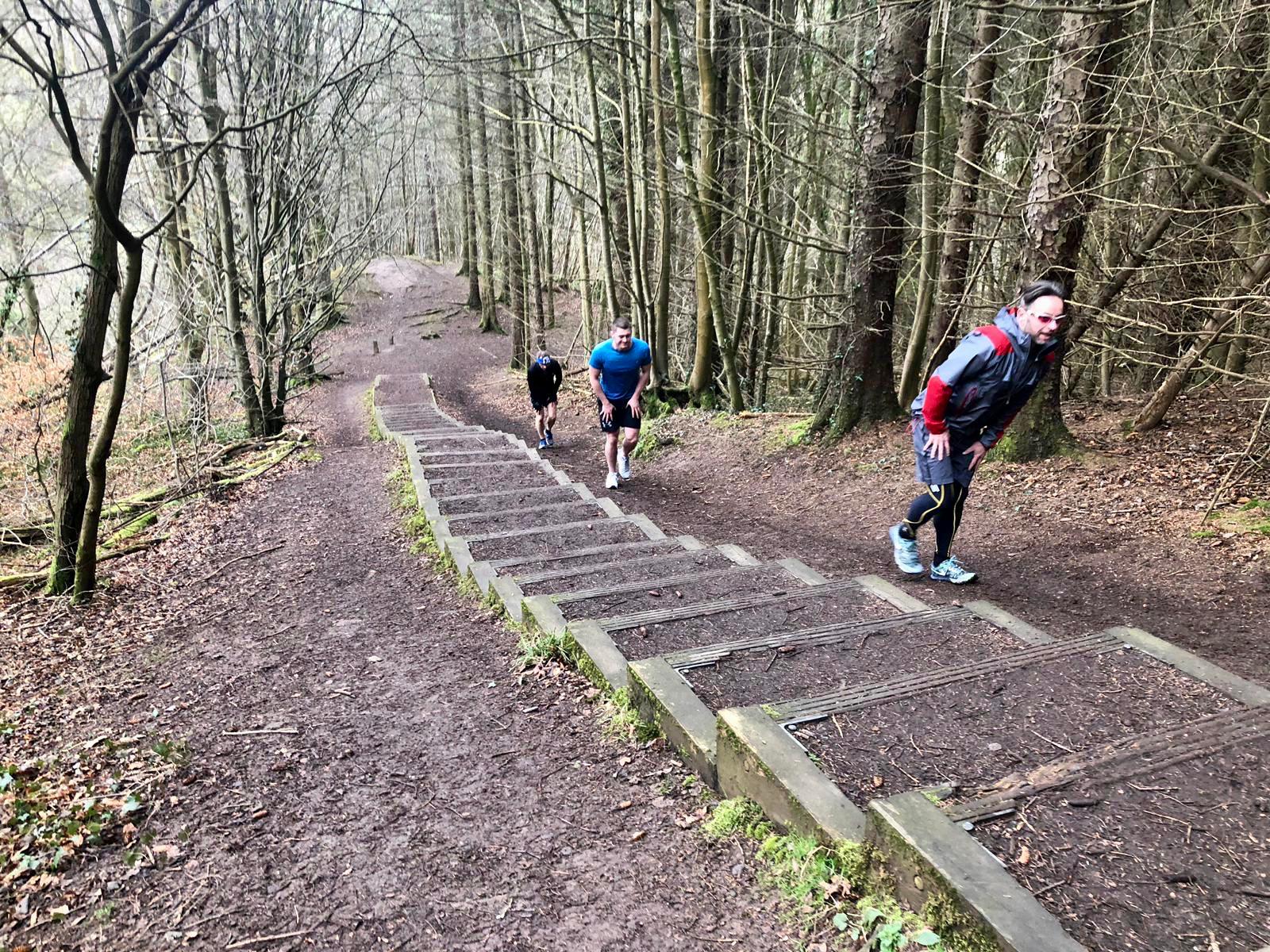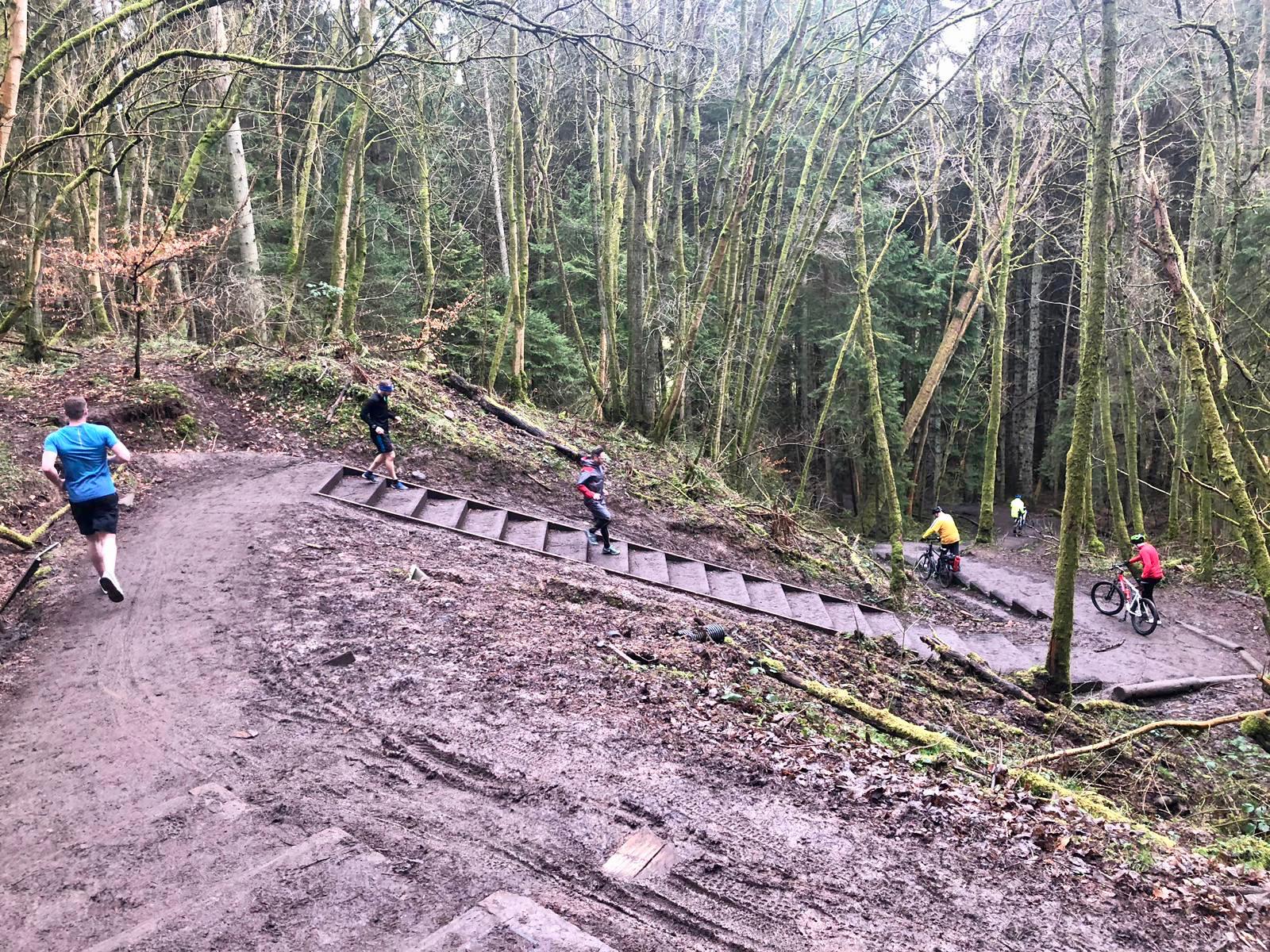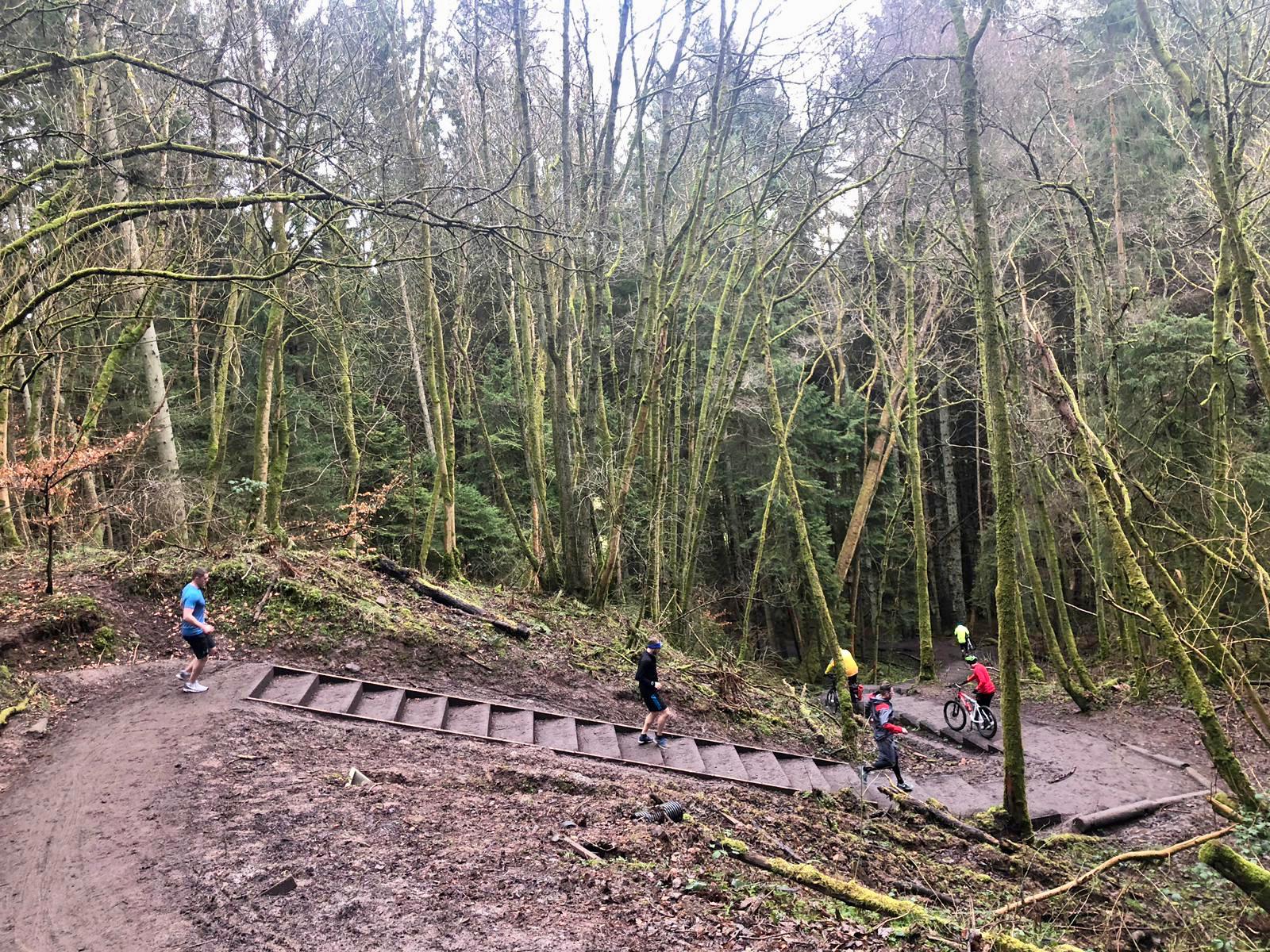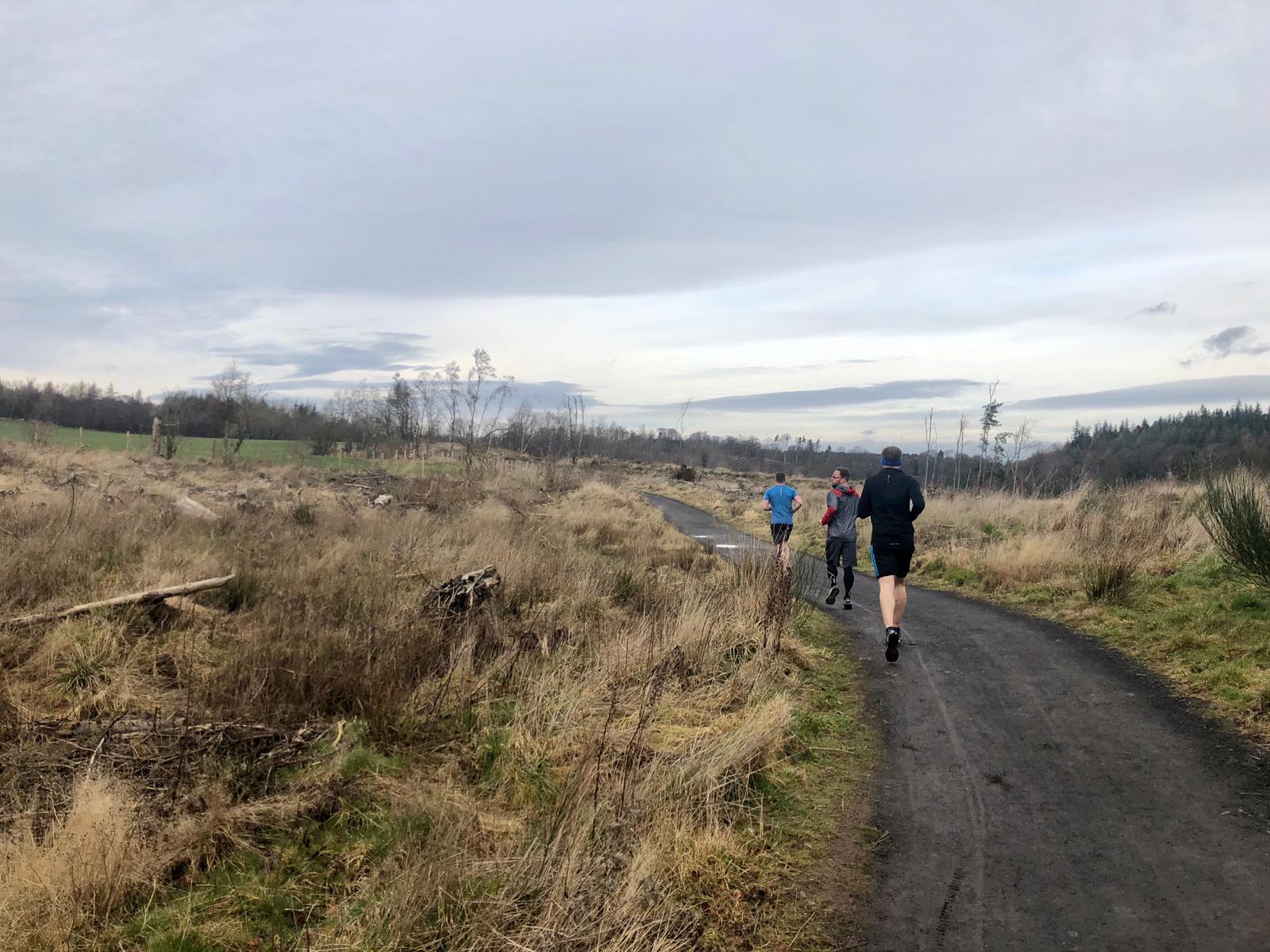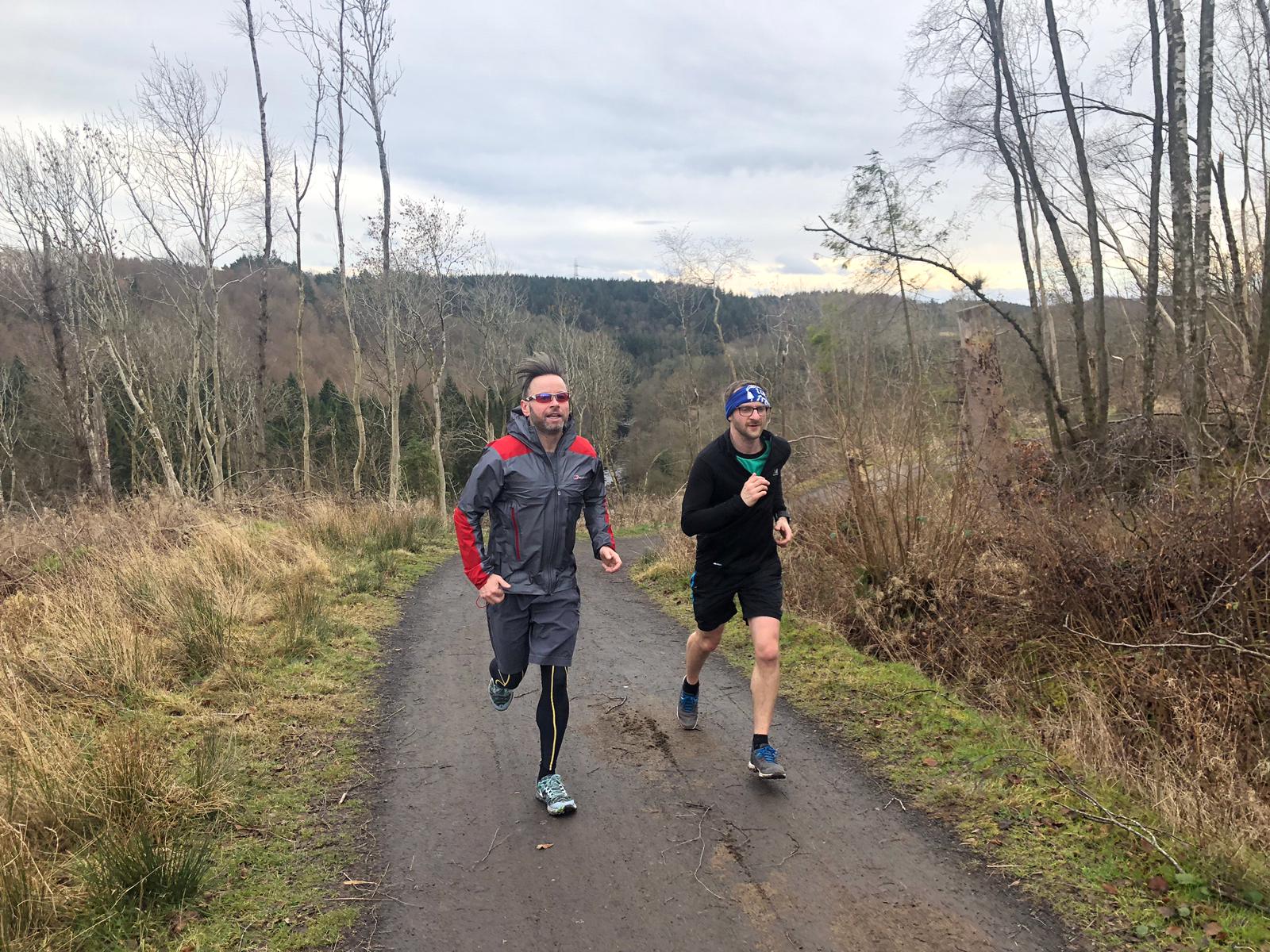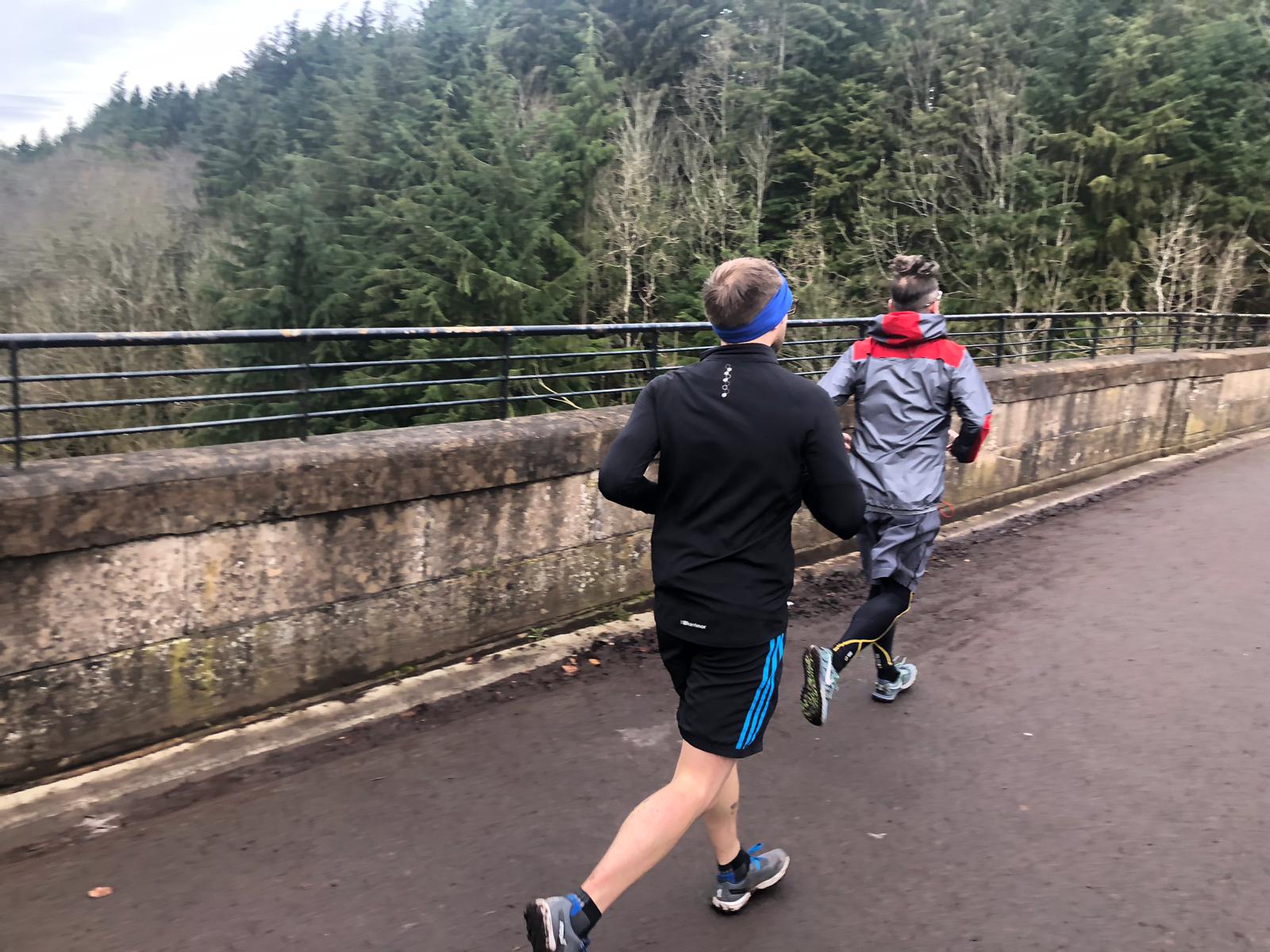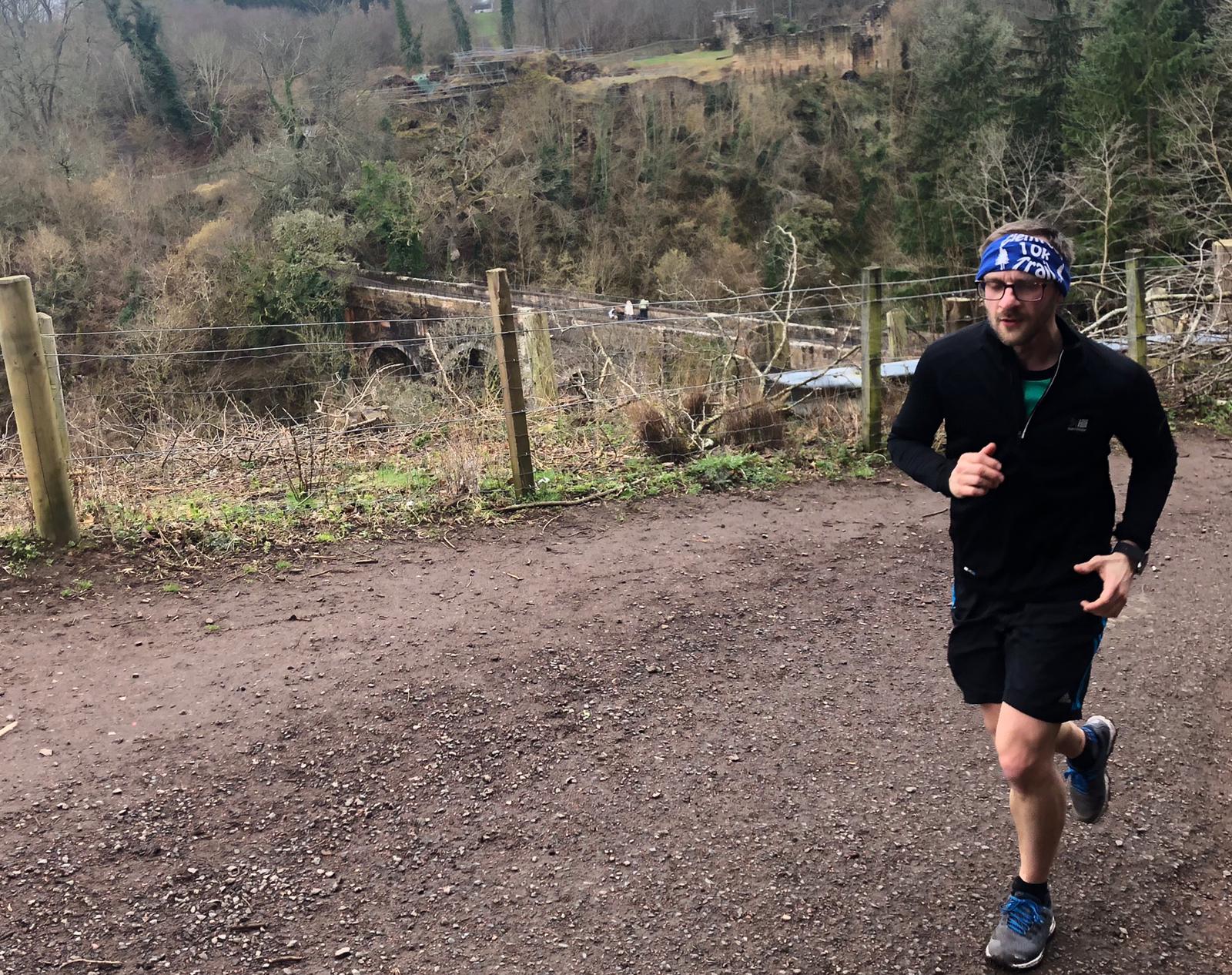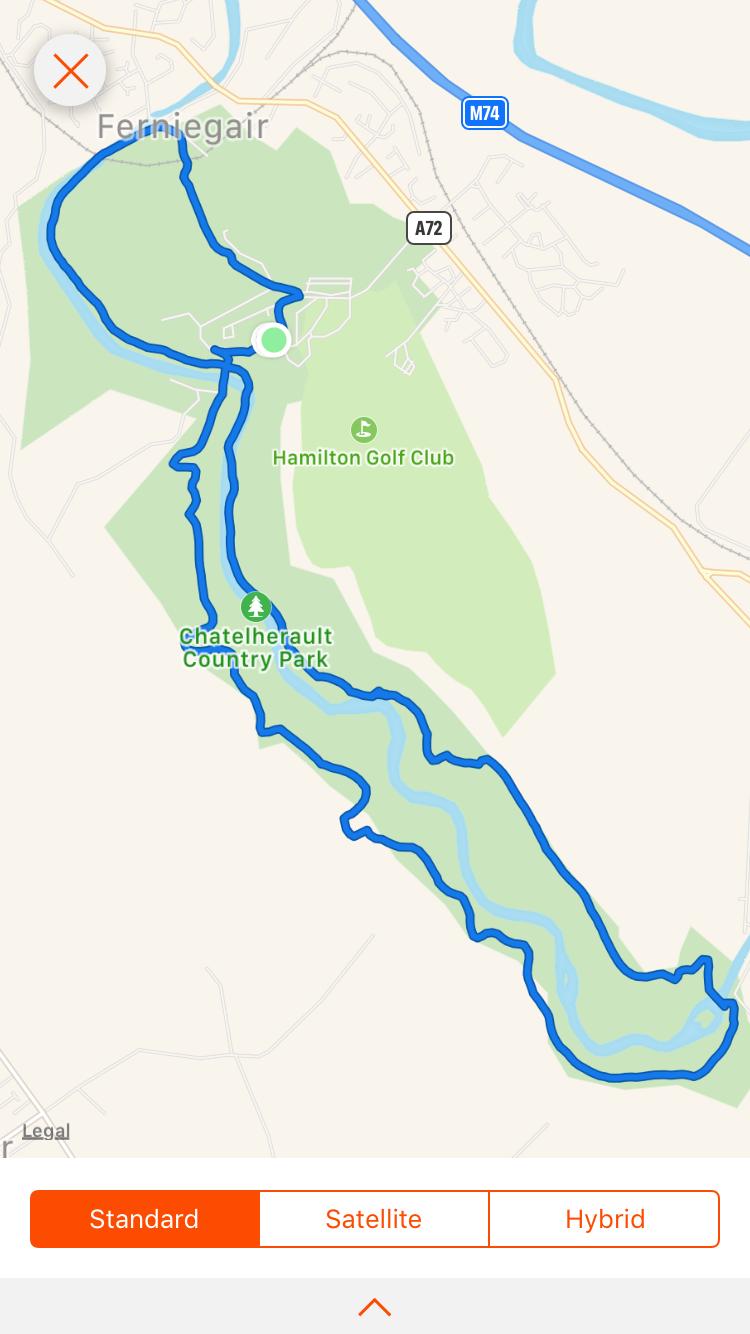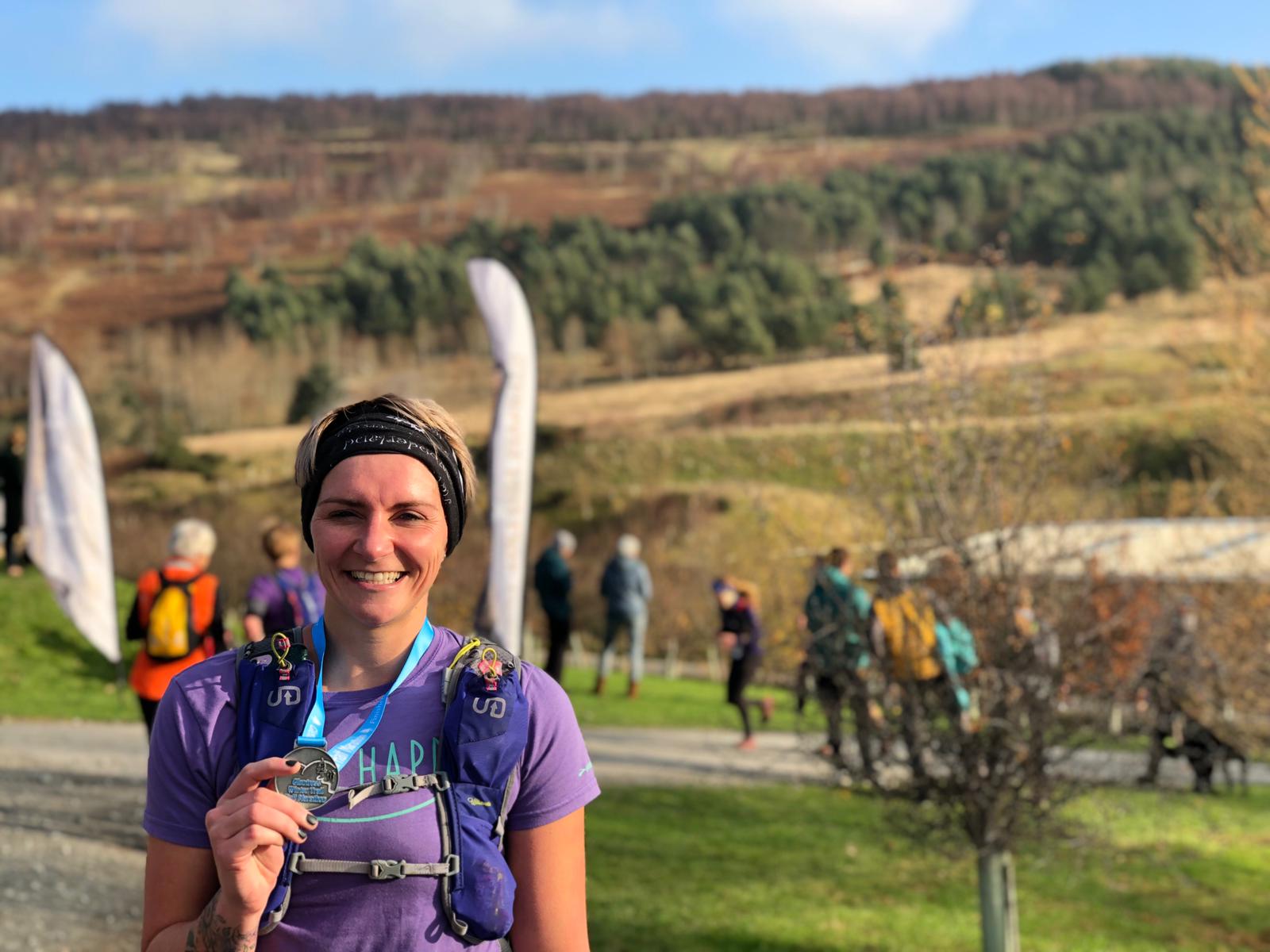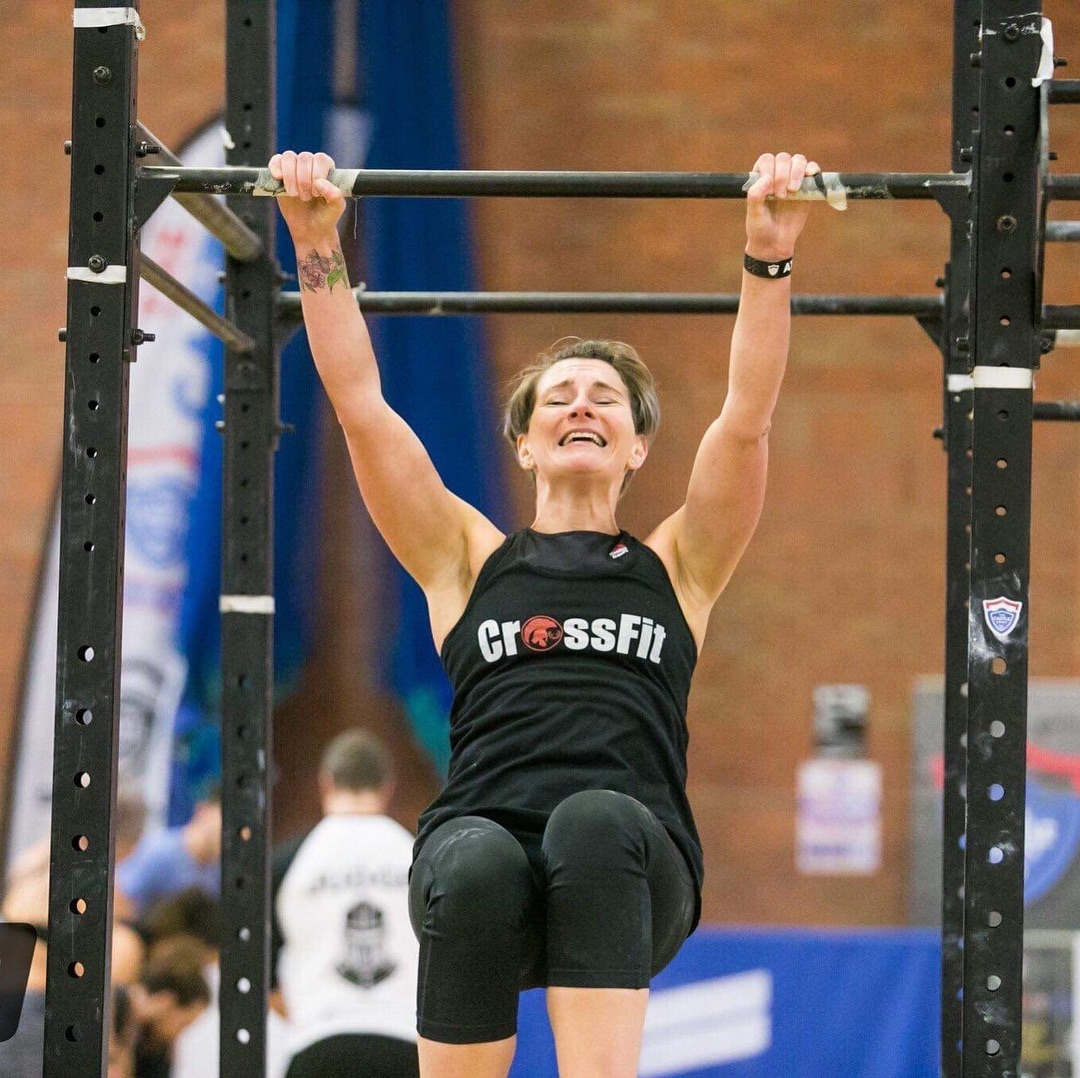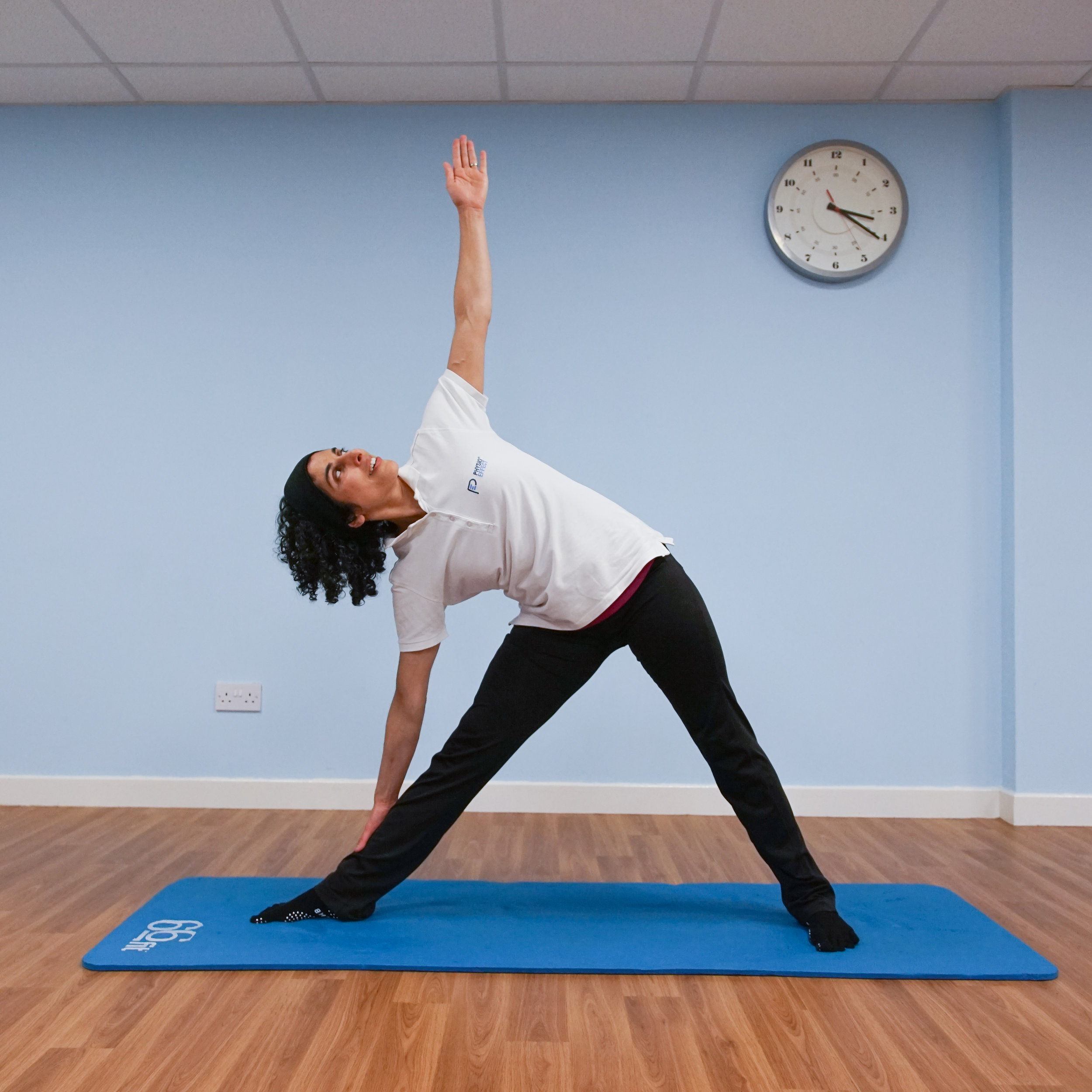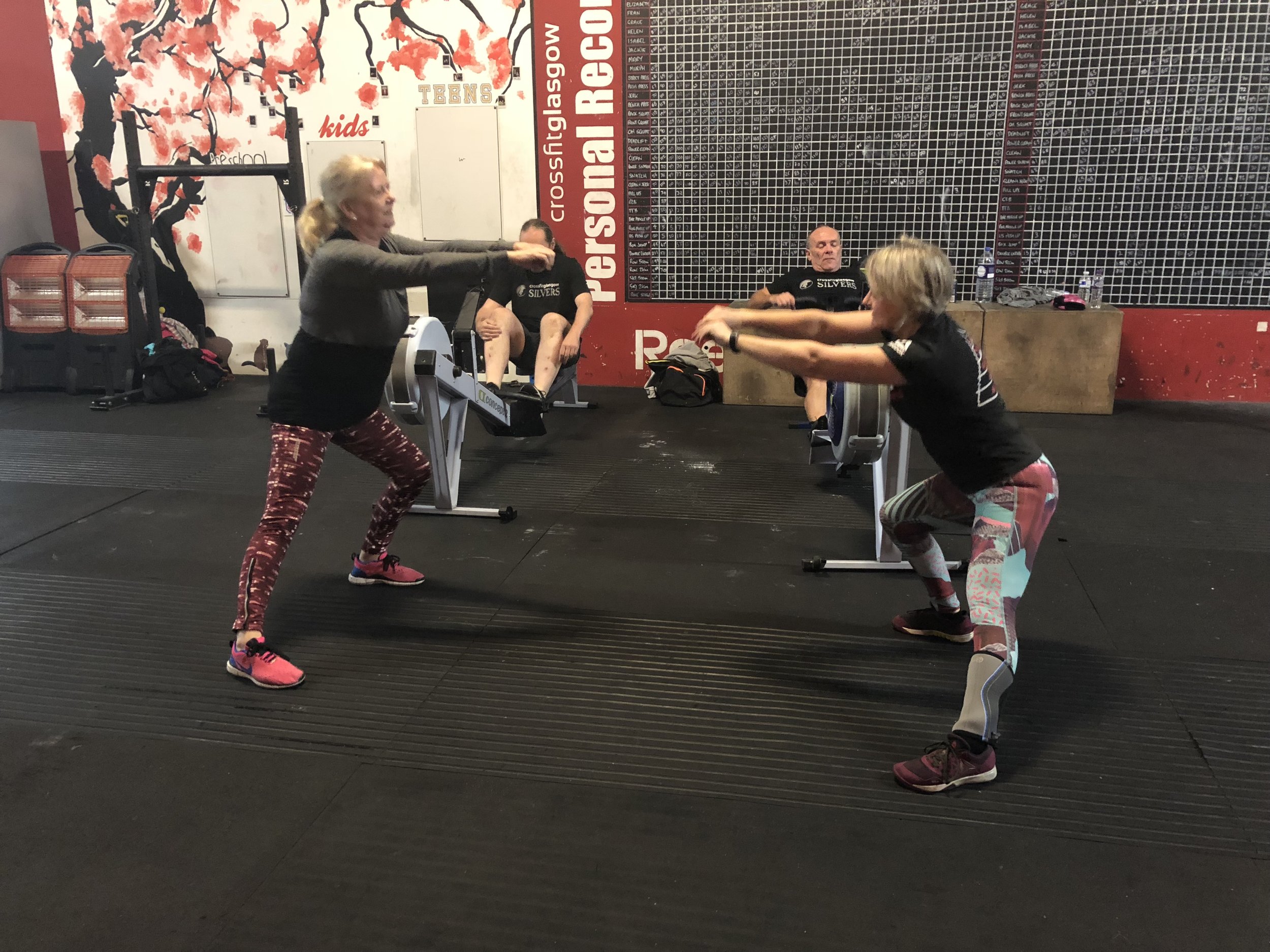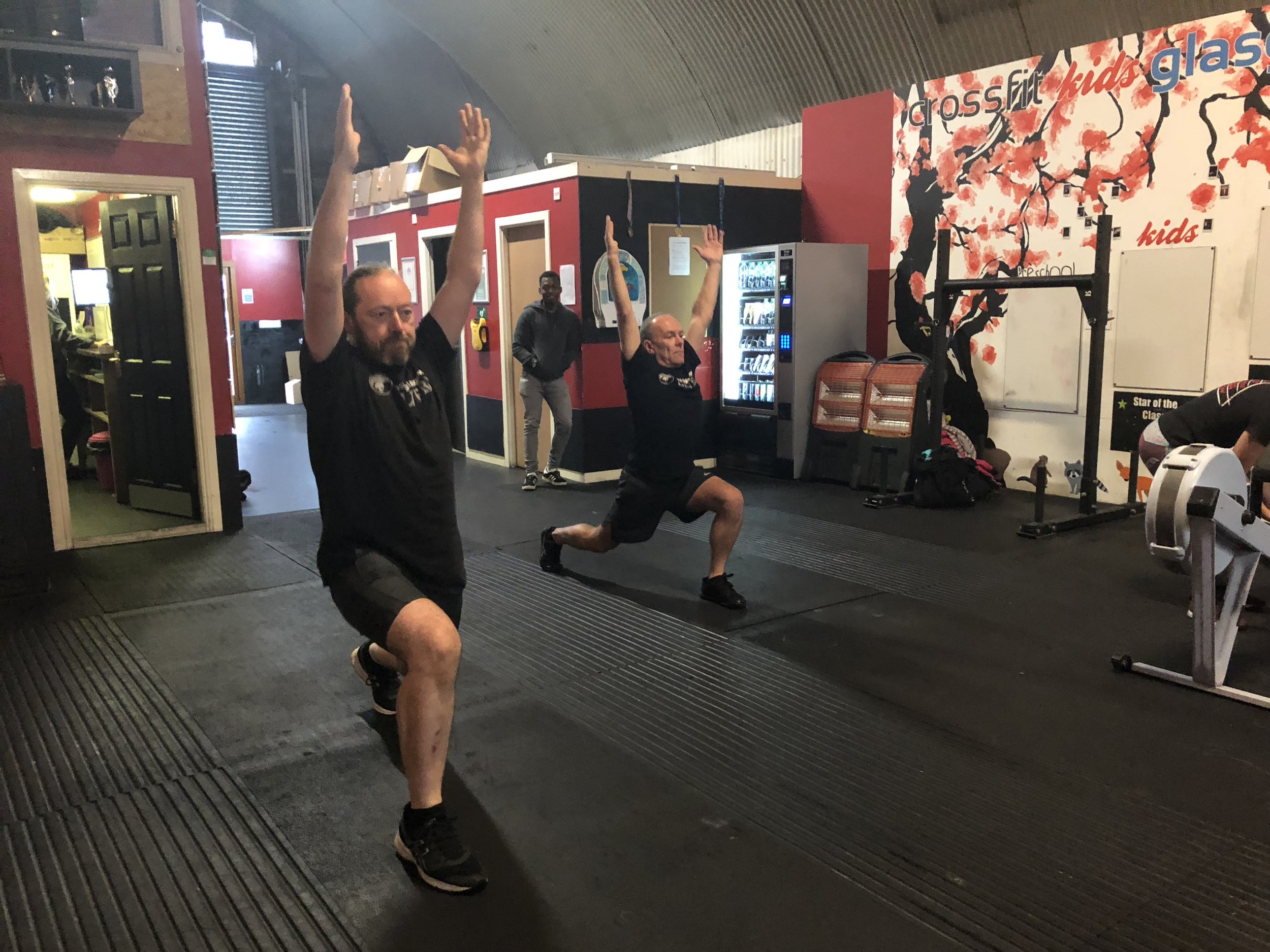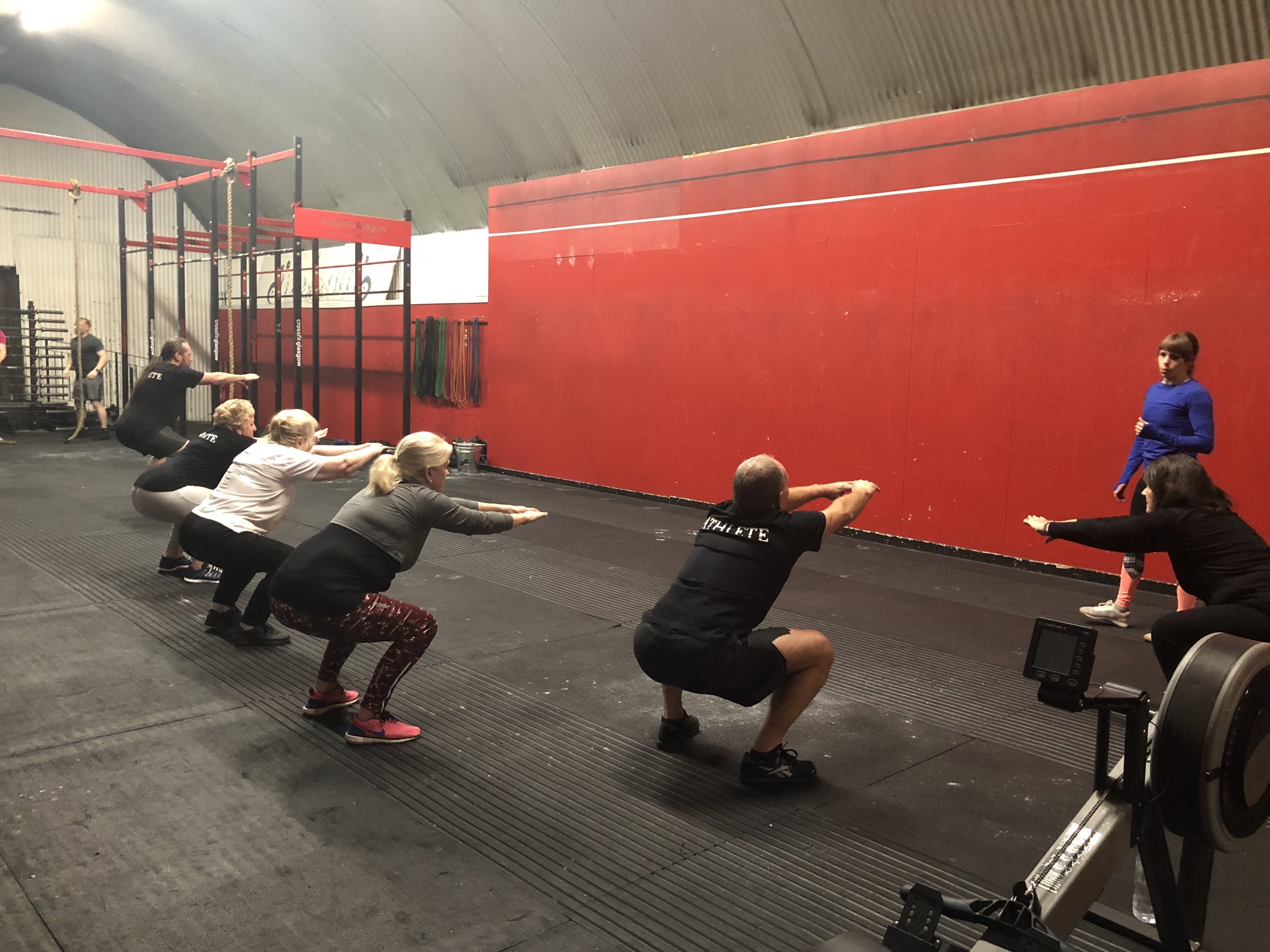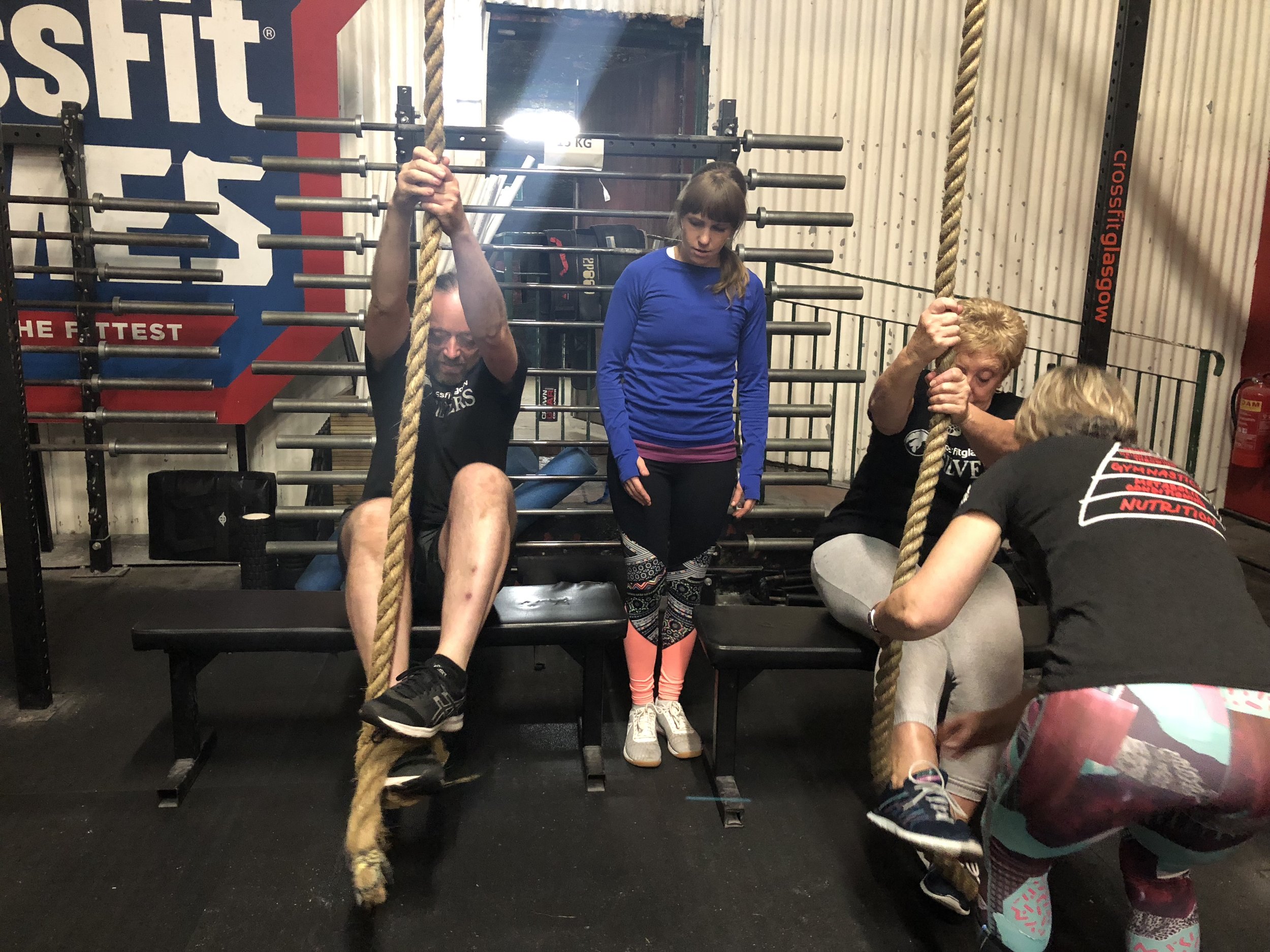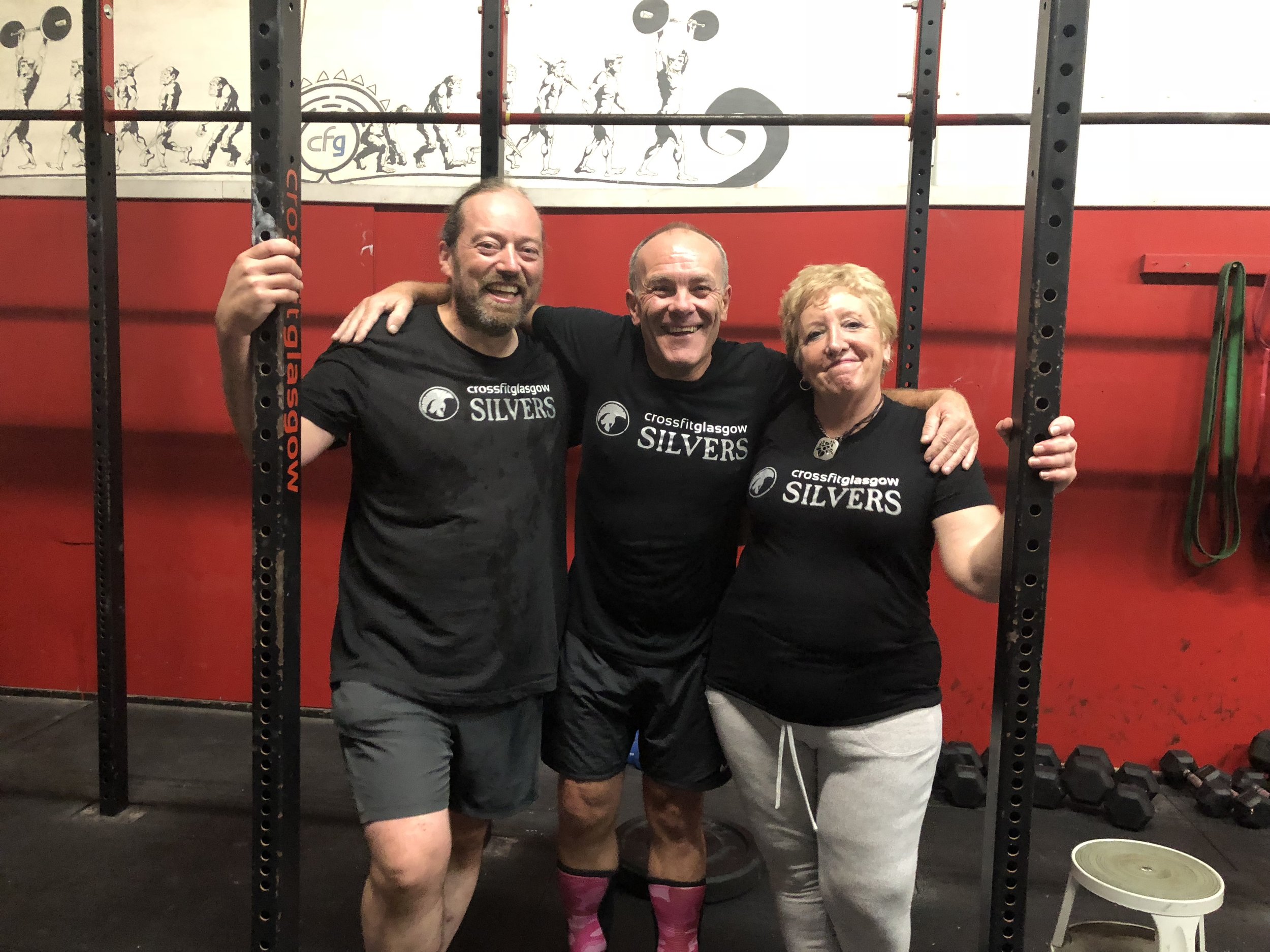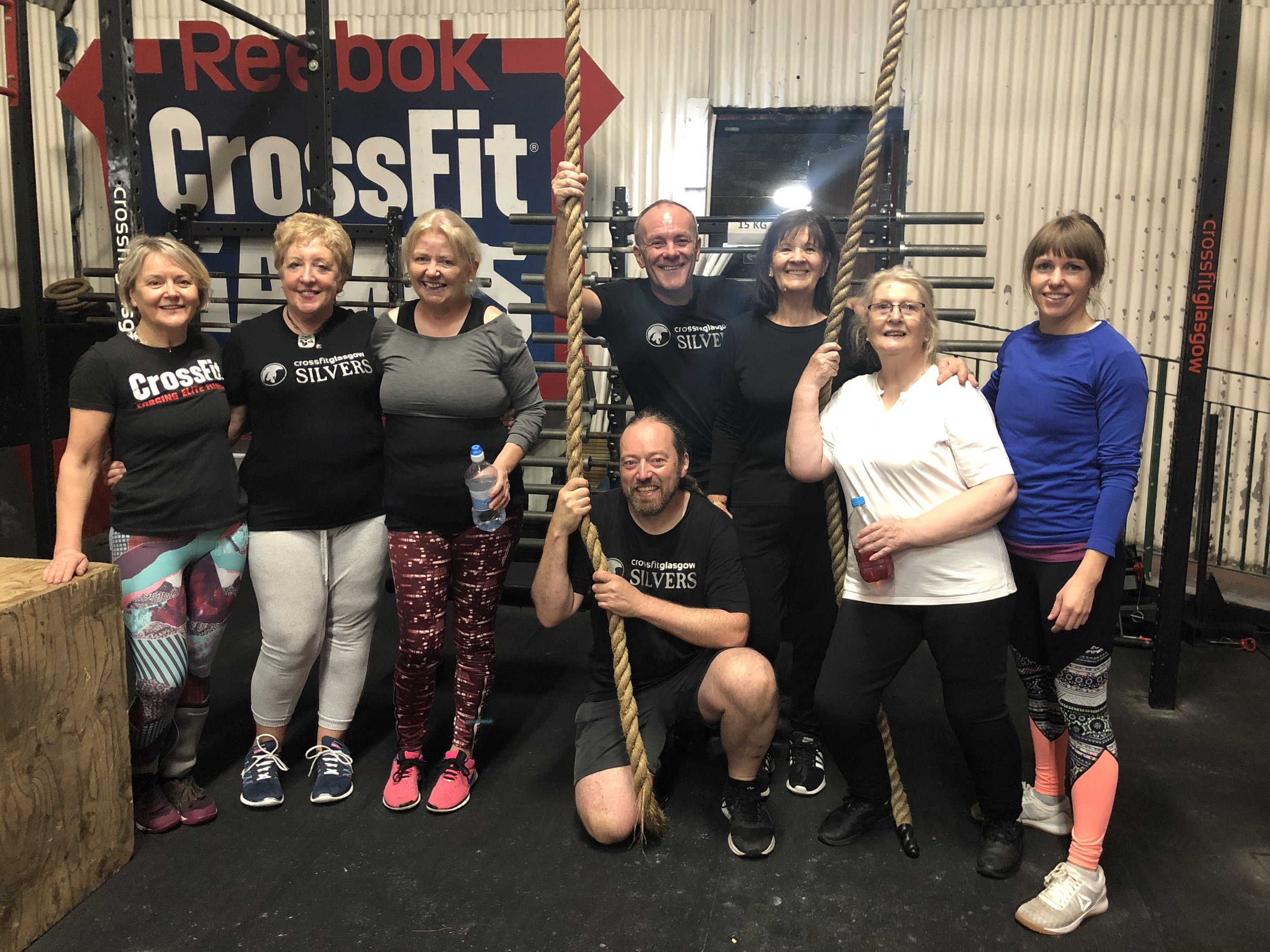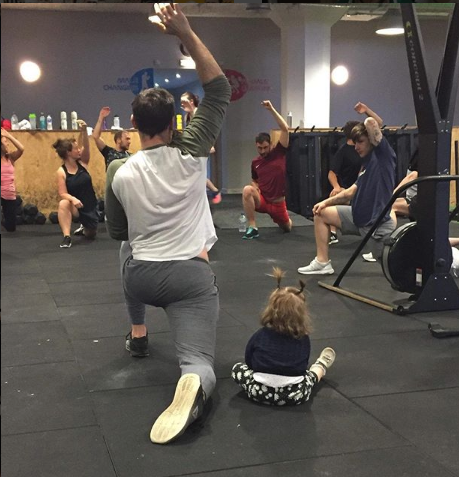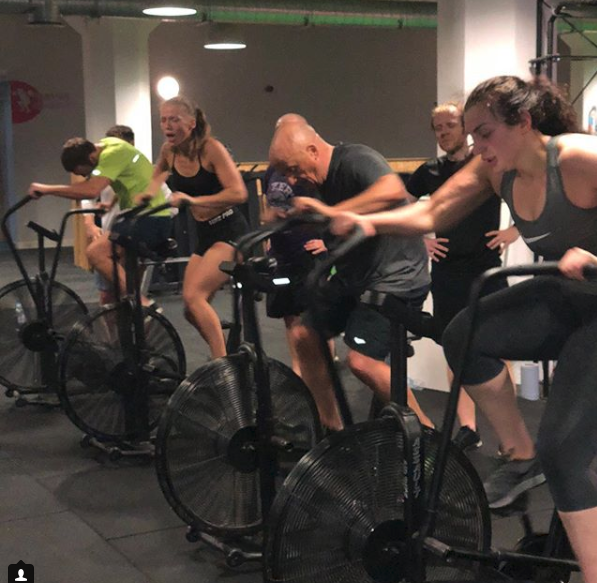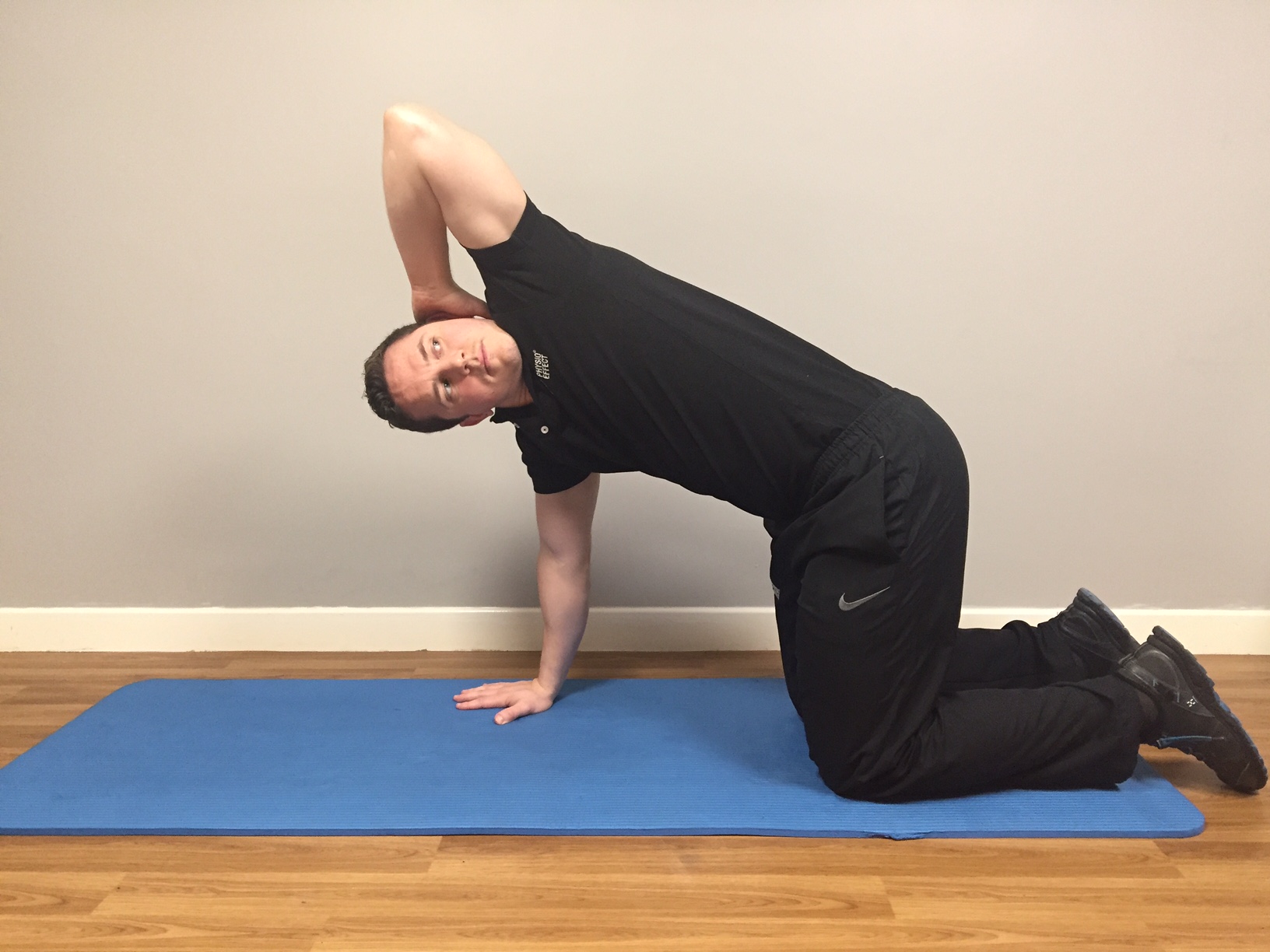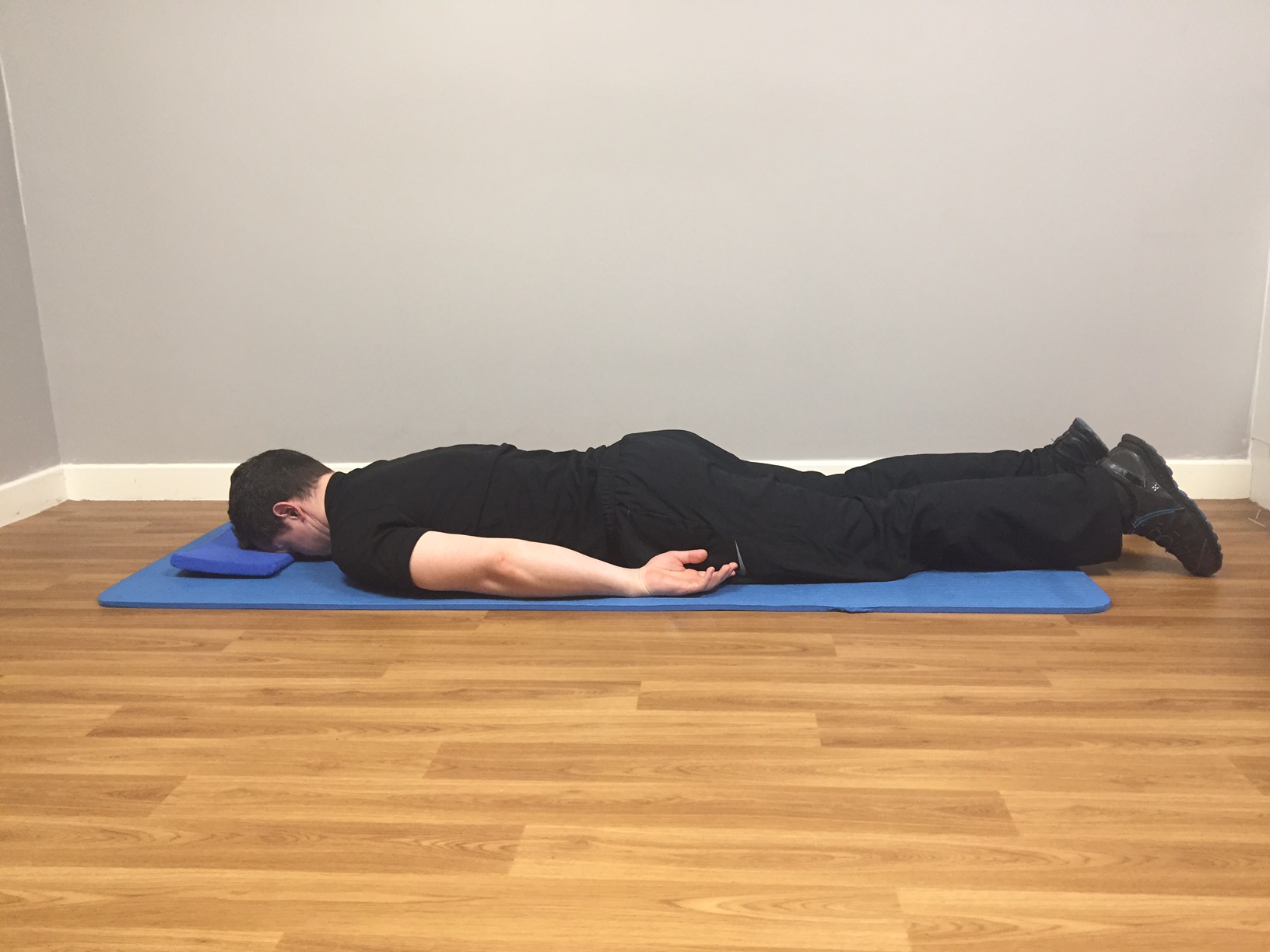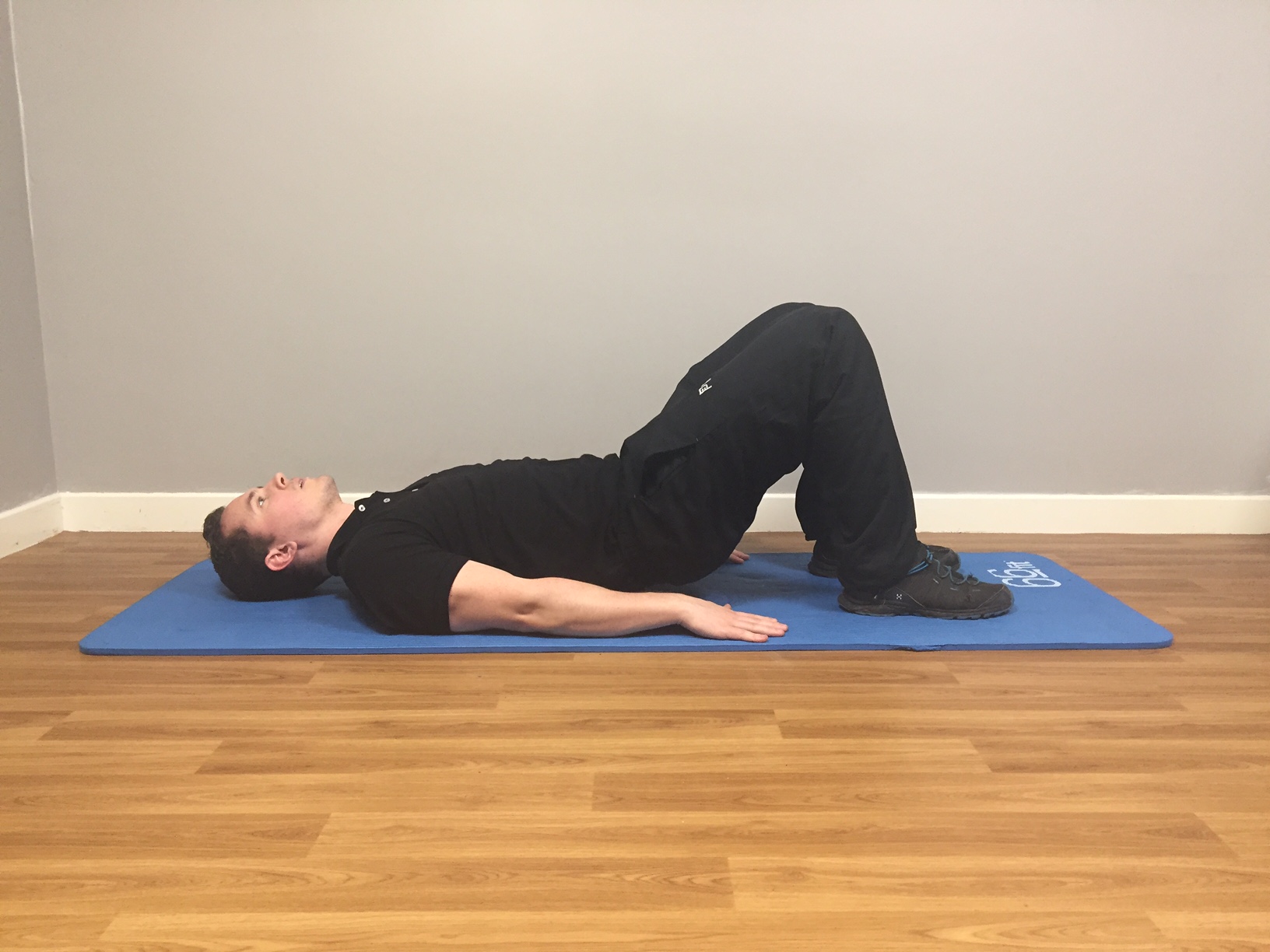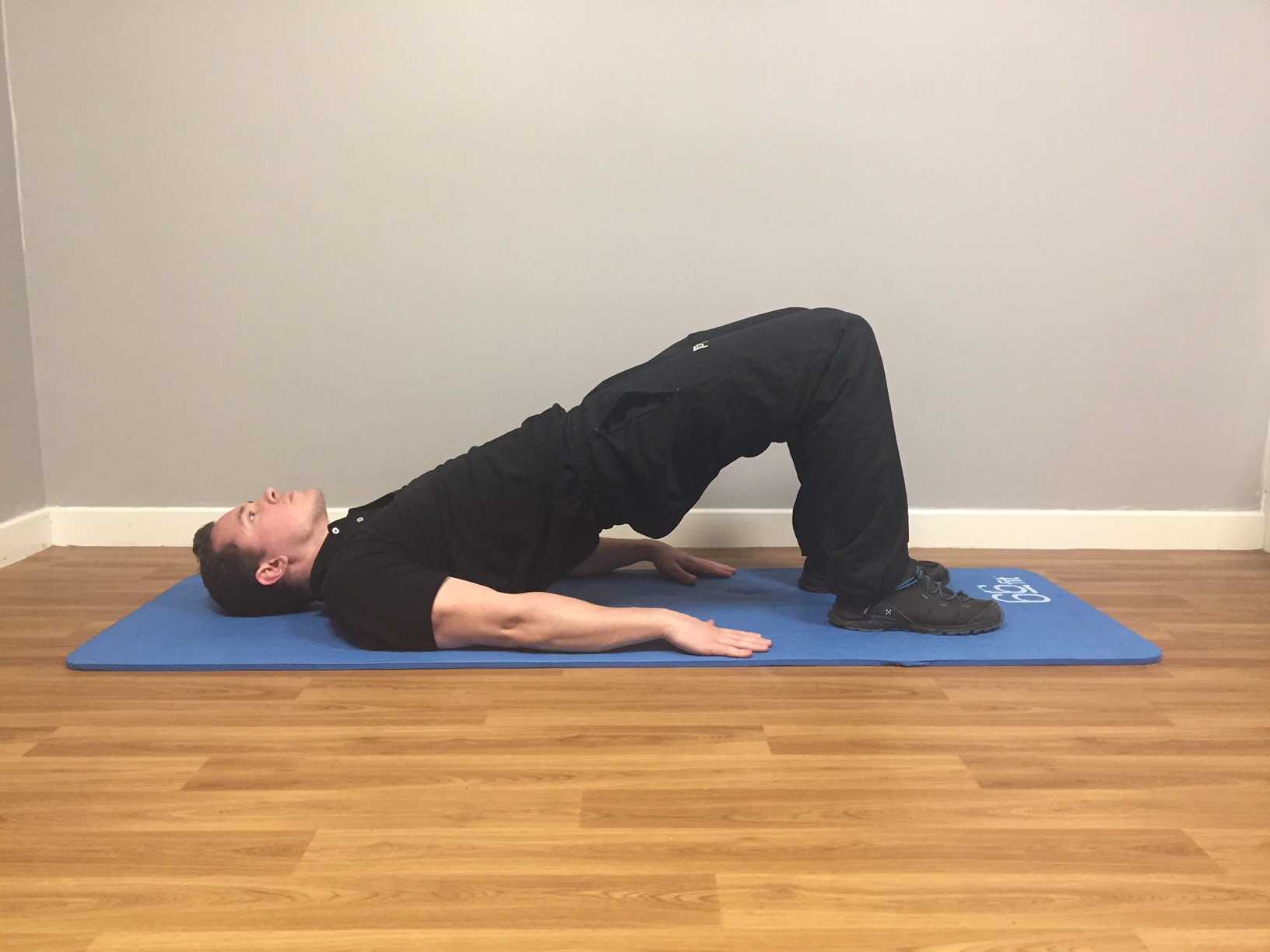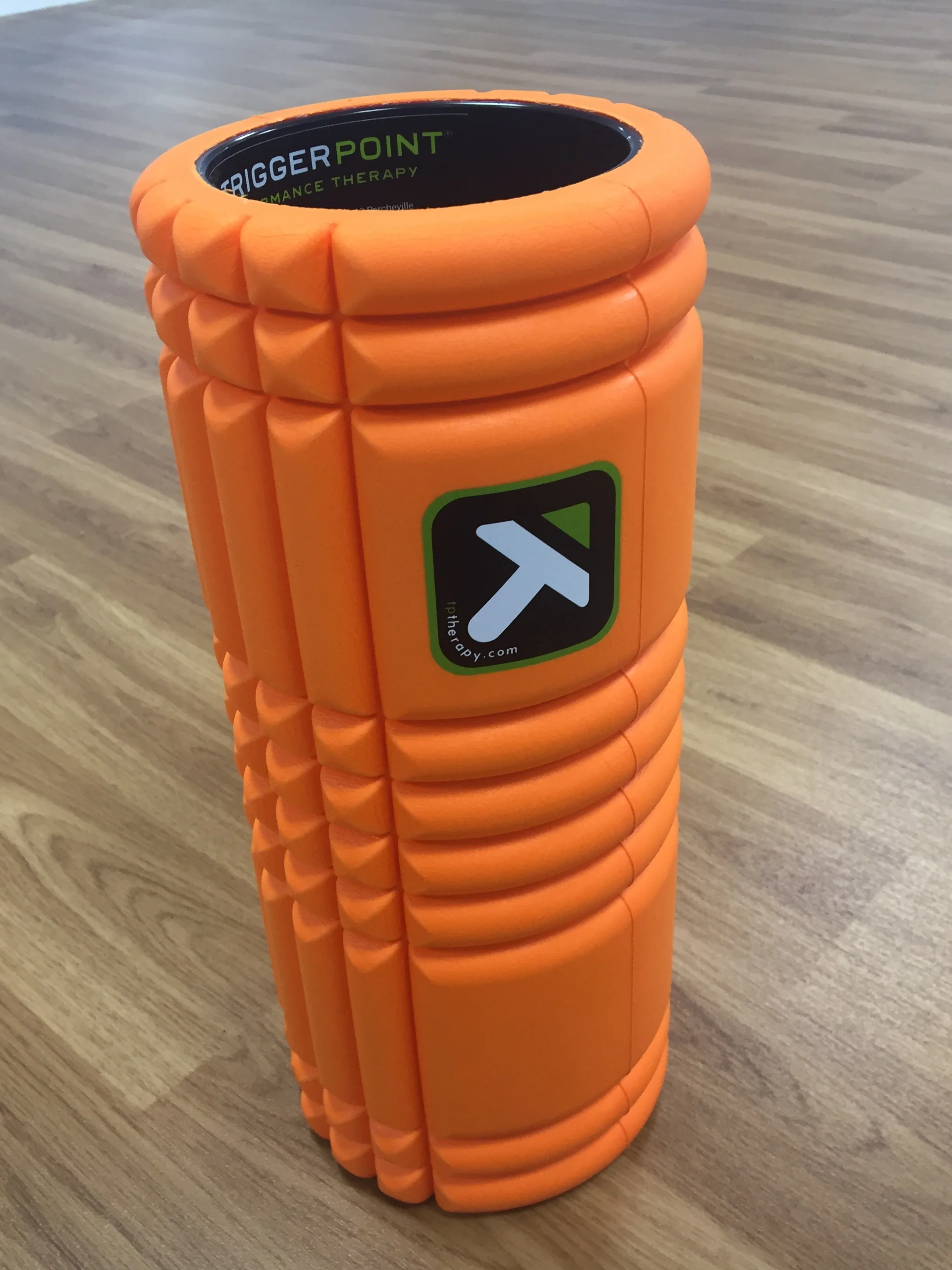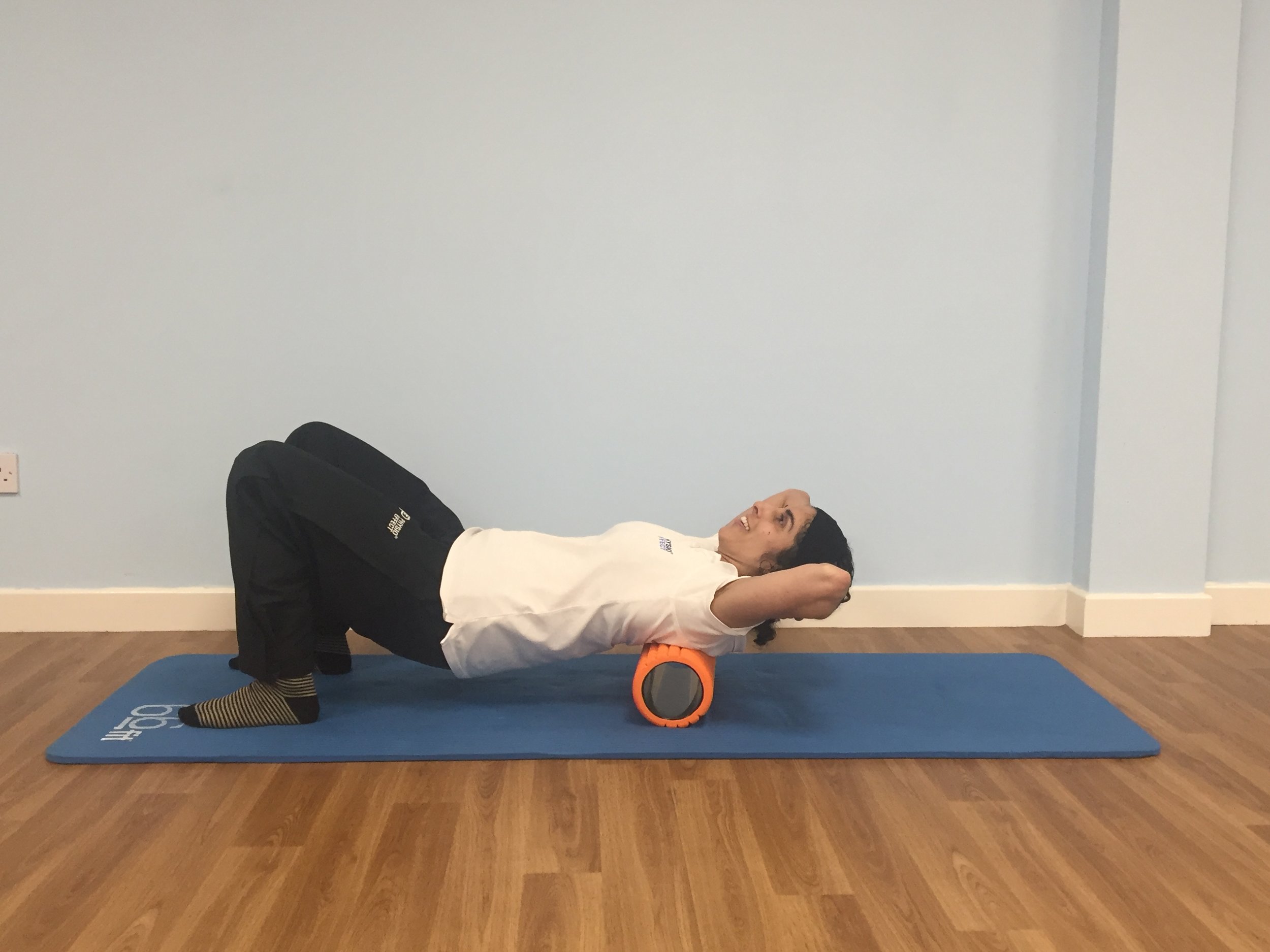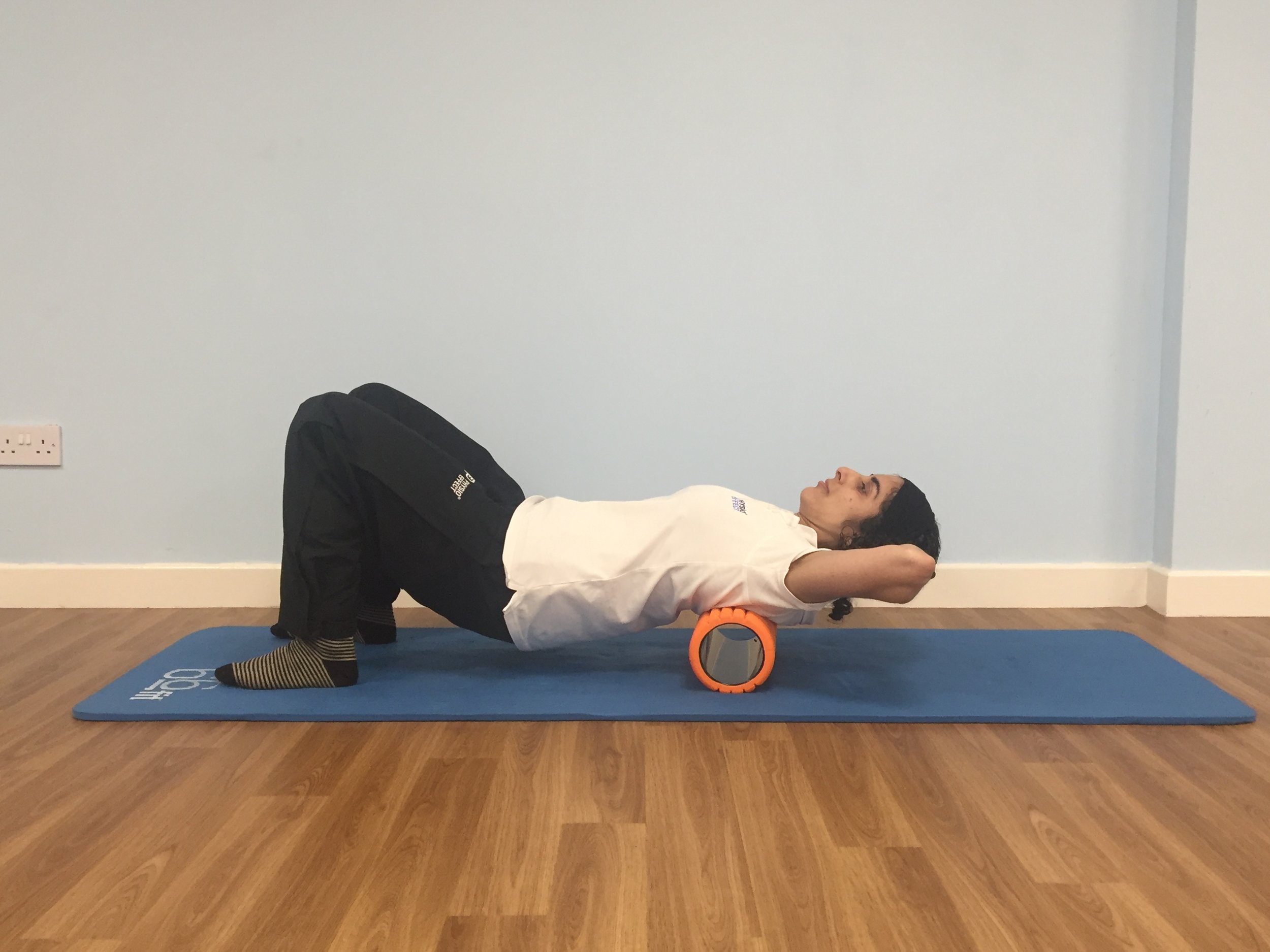Trail With Us - first session report
On Saturday March 2nd, we had our first trial trail run at Chatelerhault Country Park - it was a great session and we definitely got the best of Saturday’s weather!
A small number of beta-testers agreed to come on our trial Trail With Us run on Saturday morning…
To find out more about the informal group - please click here.
If you’re interested in joining us in future please fill in the form below - we will change the venue around and make it so it’s accessible for walkers/ runners and everyone in between - we’re even talking about having a buggy-friendly route!
View some of the footage from the event here and even more on our YouTube Channel
Real Life Stories: Recovering from a disc injury
Fiona Callan is a CrossFitter and Ultra-marathoner who injured her back in 2017. She had an MRI which confirmed an L5/S1 disc bulge with nerve root irritation. In this interview we discussed how she avoided surgery and returned to the things she loved doing best.
Hi Fiona, thank you for taking the time to share your experience with us. We know you've come a long way from a pretty bad back injury. Before we begin, tell us a bit about yourself! What type of work do you do and what's your sport/exercise/fitness background?
I work in the NHS, primarily an office based job. Preceding my injury I was also studying for an MSc so basically spent all day and night sitting at a desk.
I started running in 2008, mainly 5k and 10k distance on roads but I wasn’t very good and didn’t enjoy it so moved to trail and hill running instead when I started gradually to increase my distance. I met some really cool people to run with as well. In 2012, I was talked into a trip to Nepal by a friend but it wasn’t until around 4 weeks to go that I found out he had signed me up to an ultra marathon. I didn’t even know what that was! It was sheer determination that got me through that and I really caught the ultra marathon bug.
In 2014 I started CrossFit as I thought some strength and conditioning type training would help with my running and I had no idea what I was doing in a conventional gym. The coaching and set workout approach has really worked for me and made me use muscles I didn’t know I had.
So the big question, when and how did you injure your back? Was it after one incident or was it something that gradually built up and got worse? What were your symptoms (i.e. back pain? leg pain? numbness etc...)
To be honest I’ve always had a bit of a lower back niggle, probably postural, but thought it would just go away. It was definitely something I started to feel more when I started CrossFit as I really had to use my back and core more than I had been doing running. Slowly I noticed it had started to affect my running, I had pain in my right buttock that shot down my leg now and again and my leg generally felt heavy. If I left it a few days it would go away but it meant I couldn’t really run or CrossFit as much as I wanted to.
It started affecting my job as I couldn’t sit comfortably for any period of time. I was travelling by train to Edinburgh at least twice a week which became difficult. On one journey I had to get off the train and go back to Glasgow as I couldn’t face sitting for an hour.
Then during a workout involving a barbell I cried so much I had to admit that something wasn’t right.
My initial symptoms were primarily in my lower back, there was a build up of pressure around my stomach and back even when I bent over the sink to wash my face. I tried to keep active but really scaled back on what I was doing. I kept up my hill walking as this is an activity I love doing with my nephew – I used poles and made Ewan carry my bag as he’s the young one! I tried running but could only manage 1k before I felt my back stiffen.
One Saturday I went walking with Dad and Ewan in the Lake District. It was an amazing day. The hill wasn’t too hard; we took our time and enjoyed it. It was the shooting pain in my right leg that woke me up early on the Sunday morning. I tried to stand up but my leg just wouldn’t work. I limped to the bathroom hanging onto the wall and at that point I knew there was something seriously wrong. It sounds dramatic but I genuinely felt paralysed down that whole side of my lower body, first thoughts were ‘I’ll never run again!’ and panicked. My boyfriend called NHS24 and a nurse managed to calm me down and suggested I took paracetamol with ibuprofen and try find a comfortable position until a doctor could get to me. A few hours and one injection later the pain had dulled. He said it was my sciatic nerve; I should try to relax and spend less time sitting down!
What was the initial management i.e. what treatment did you seek?
I got an appointment with Jonny who did some needling on my lower back/ glutes and gave me some exercises to do. I am the most impatient person and after a week of exercises I didn’t feel any different so I saw another physio (sorry!) who basically told me the same thing and gave me the same exercises. I really was in denial about how serious it was. I spoke to coaches in the gym, chatted to other runners and did a lot of Googling but all the answers were the same.
It was the mental part I actually found the toughest to deal with. I have made so many friends through running and CrossFit and my social media is full of it too so I was always seeing and hearing about all these amazing runs and PBs. I just felt stuck and disconnected. I saw my GP as I really felt like I was struggling to cope. People were always asking how I am and telling me I should ‘do this and do that’ and eventually I just got fed up talking about it. My GP didn’t really help me; she referred me to her physio friend but I didn’t go.
At the same time, Jonny had passed me onto Mariam for Clinical Pilates and it was during my consultation that she suggested some short term medication for my nerve problem in my right leg. I went to another GP for this and as well as giving me the medication, he was really keen to get me back running and to the gym so he referred me for an MRI.
Am I right in saying you ended up seeing a consultant neurosurgeon? What did the MRI show?
Yeah I was really lucky in that I got an MRI pretty quickly. I think the 2nd GP had something to do with that. A few weeks after the scan. I received a letter with a hospital appointment but with no other information. Frustrating and worrying. I thought well there must be something not quite right and because of my problem with patience, I called the GP and asked him to give me a brief overview of the scan. He said he could see a disc bulge and I should continue doing my physio exercises until my appointment. I had just started with the Clinical Pilates class so I let Mariam know the issue and she tailored exercises for me until I found out more about the problem.
So there was the prospect of having surgery? How did that make you feel? Was this something on the cards or wanting to avoid?
I remember getting a phone call from a surgeon in the spinal unit and it made me feel sick. I actually don’t remember what he said to me as the idea of back surgery just terrified me. I wasn’t exactly in crippling pain so the idea of surgery just felt a bit extreme to me. This was something I definitely wanted to avoid. I just really trusted my physios and they really believed I could get better without it. I didn’t feel that my pain was bad enough for surgery – for me this was the last resort, I’ve never heard positive stories about it.
At the appointment, the doctor went through my scan which I found fascinating. I actually felt a bit of weight come off my shoulders when I could physically see the issue. It had been hard to accept when I didn’t know for sure what the problem was but there it was clear in front of me. She then told me that they would do surgical intervention if I was getting sharp pains down the top of my leg. I told her I had that a few weeks before but it had been getting much better. We left it at that and I was told to get in touch if anything changed.
I had so many conversations with my boyfriend, my parents (and myself) and decided that it wasn’t the end of the world if I couldn’t run 50 miles or couldn’t deadlift 100kg as long as I could stay active. I would just scale back what I was doing.
You've spent the best part of a year doing some serious rehab with Clinical Pilates. In your own words can you explain what that is and how it helped you?
I had done a bit of Pilates before as I’d read and heard it was good for runners. It was one of those things I struggled to stick to because I never left the class feeling like I’d worked hard and my issue with patience didn’t help. When I told my boyfriend about it he signed me up for 6 weeks because he knew I’d have to go if he paid for it! I noticed a huge difference after these 6 weeks.
It is basically pilates but physio led so your exercises are all tailored to whatever issue you may have so we’re all doing something different generally. It’s a small class but everyone is in the same boat and really friendly. Mariam checks in with you regularly during the class and pushes you when you’re ready but also changing exercises if something isn’t quite feeling good.
I expected my exercises to all be lower back focused as that’s where my injury was but actually they’ve been full body movements. As well as having a stronger back, I have a stronger core and much improved posture. Mariam also spent some time working on my legs, particularly my right leg as the nerve had been affected and I had limited movement and very little strength.
Eventually you returned to CrossFit and trail-running. How long did that take from when you first injured yourself?
I was always doing a scaled back version of CrossFit and a bit of trail running while I was injured but I was mindful of undoing my hard work. It was important to me mentally that I kept in touch with coaches/ friends in the gym and my runner friends.
I accepted my injury in May 2017 and started Clinical Pilates in the October. In May 2018 I was a more confident runner so decided to train for a race following a plan, building up in distance and I finished the Mad Hatters Half Marathon and the Glentress Half Marathon with a PB and no back or leg pain. Not quite back at ultra marathon distance but I’m actually enjoying the shorter runs at the moment. In June 2018 I started back at CrossFit and noticed that I’m better at a lot of the movements as I actually use my back and core as I should. I’m always conscious of loading too much weight on bars and I know certain movements still aggravate my back but I know when to stop and I just need to gradually build my strength back up. I was asked if I’d like to be part of a team from the gym for a CrossFit competition, I said yes why not I can try and we finished in 3rd place with no back injury!
Most people in this day and age are seeking the "quick-fix" or miracle cure. In fact, most people in your shoes would opt for surgery given the opportunity. What advice would you give them?
Your back is such a major part of your body so decisions on surgery should never be made lightly. Unless a professional is telling you there is no other option I would encourage people to commit to the exercises, spend less time sitting down and stay active by doing anything you find fun (that’s obviously not going to hurt you)
Working through this injury has taught me so much about my body and my lifestyle as well as making me a better runner and CrossFitter. This is all coming from the most impatient person!
Clinical Yoga - from a client perspective
When Raz Leonard, one of our Physio Team, suggested developing Clinical Yoga to create a platform for her to be able to help Physio Effect clients have another options through which to achieve their goals, we thought it was a great, and really interesting idea! Read more to find out how our Clinic Manager, Sarah, got on!
Introduction
Physio Effect has run specialist Clinical Pilates services for a number of years now; the way i explain clinical services as opposed to ‘regular’ services is that with the clinical option, you’re being instructed by a Pilates instructor who is also a qualified physiotherapist and who uses that amalgamation of learning to structure the service. We offer 1:1, 1:2 or classes here in our Northside Studio. The classes are small - maximum five people, and, whatever session size you choose, you have a clinical assessment with that physio before you start. They go through a specific assessment with you and work with you to identify your physical needs and ultimate goals for the outcome of the Clinical Pilates sessions.
I guess the Clinical sessions could be seen as bespoke rehabilitation (or prehabilitation) sessions which last a full hour and use a variety of our equipment here in the studio - everything from resistance bands to our reformer (see here for more!)
So, when Raz Leonard, one of our Physio Team, suggested developing Clinical Yoga to create a platform for her to be able to help Physio Effect clients have another options through which to achieve their goals, we thought it was a great, and really interesting idea!
Fast forward a month or two and I thought I’d try it out!
My Background
I’m Sarah, the Clinic Manager here at Physio Effect (hi!). I’ve done yoga on and off for around 20 years, sometimes very intensively and sometimes (more often than not!) much more sporadically. I’ve been to classes (Hatha, Ayengar, Ashtanga and Bikram) and done some at home. My brother is even a yoga teacher and yoga teacher trainer, so I know I should do more of it and really do understand the benefits. It’s just, you know, making the time (same old!).
The kind of yoga I always enjoyed was the more fast-paced, ‘power yoga’ where one posture flows into the next and I always thought I had a really good basis for this as I had a strong history of all the static postures initially.
What I hoped to achieve
As with most of us, I don’t spend enough time before or after exercise (or even independently to be honest) doing all the restorative things I should be doing - stretching being the big one here. So I hoped my yoga class would provide some balance to all the other physical aspects of my lifestyle.
How it all worked - 1:1, booking in for the block etc
Raz and I had a 1:1 session where Raz asked me about my lifestyle, goals for the class and where she asked me to do a range of movements to determine where I had limitations. This was really interesting as it identified a lot of things I was unaware of!
How the classes went
The classes were 60 minute sessions which, like any yoga class I’ve been to, started with standing postures and moved to sedentary and then lying down. That’s pretty much the only similarity as Raz had created a programme for me using yoga postures in a way that would help address my physical limitations - for example, I have, it turns out, very tight hips, so, in one session, we tested my squat depth and determined where I felt the strain, worked on that with a specific yoga posture, re-tested the squat, figured out what was the next limitation, did the next posture for that issue, and so on. It was really effective!
In addition to this, as I’ve mentioned above, I was under the impression before I did these sessions that my experience in yoga over the years had left me with pretty good posture and form in the yoga poses. Boy, was I wrong! When in a class where the instructor has the time and attention to detail to make sure you’re as aligned as you should be, it can make a massive difference with no option for those muscles that tend to overcompensate to do that.
Overall feeling and summary
I gained a real insight into how yoga can support and push my training as well as improve my recovery and flexibility. Clinical Yoga can be used to identify issues and give us the tools we need to overcome them as well as helping overall performance in a variety of ways.
The classes are great fun and I’d heartily recommend you consider signing up, if you like the sound of it!
“I thought I would just drop a short note about my experience in the 6 week yoga course.
I have to admit that before I attended a class I did not give yoga a moment’s thought because I did not know anything about it. When you said that you were running a course at the same time a friend on facebook who runs a boxercise class posted that he had just completed a yoga course and was singing the praises of it so I thought well if I don’t try it I will never know. I am glad I did and having attended all of the classes in the course I can feel the benefit of this.
Stretching to improve mobility is one thing but knowing which stretches are most beneficial and how to do them correctly to get the best results are very important. When doing stretches at home I believe that I am doing them correctly but that was in my own eye. “Oh wad some power the giftie gie us, To see oursels as other see us”. The benefits and results from the course greatly exceed anything that I could have achieved at home.
I have also found that when exercising at home there are too many distractions around. Being committed to attend the course provided focus on what I had to do in a controlled environment devoid of distractions. Maximising results from my efforts.
Thanks again”
Case Study: Frontal Knee Pain (Part 3)
Single leg exercises should be incorporated in strength and conditioning sessions as it is the best way to mimic the single leg work required in running with landing and push-off. It is also a good way to identify any imbalances from one side to the other. In the final part of this series, Jonny’s pain had largely settled and his rehab focused on single leg control. He also practiced a more efficient running technique to minimise loads placed on the knee.
Case Study: Frontal Knee Pain (Part 2)
During the initial stages of rehab, the primary focus was to maintain muscle function which can be inhibited by pain. During assessment, it was also established that Jonny was weaker on one side of his outer hip muscles (glutes) when looking at the way he balanced on one leg. The video below looks at a couple of simple exercises he worked on to improve this.
Case Study: Frontal Knee Pain (Part 1)
Knee pain is a common issue in runners. It can start off as a niggle and can easily be ignored until the point where running is no longer tolerable. This is frustrating particularly when training for a race or event. In part 1 of this month’s case study, we will look at some common physiotherapy techniques we use for pain relief in the treatment of anterior (pain in the front of) knee pain.
Jonny hurt his knee during a 42-mile Ultra Marathon which was on trail and had plenty of up and down hill sections. This caused an acute overload of the structures around his knee cap, causing pain and swelling.
Case Study: Ankle Sprain Rehab - Part 2
Part 2 of our ankle rehab case-study following Mariam's injury two weeks before a trail marathon.
Part 2 of our ankle rehab case-study following Mariam's injury two weeks before a trail marathon. This is a sports physiotherapy approach to the treatment and management of an injury leading up to a specific event. In this episode, we looked at progressing her exercises and training modification leading up to the run.
Feeling inspired by "Silvers" at CFG!
Raz Leonard, one of our Physio Team, recently visited the older adult class at Crossfit Glasgow (CFG) and taught some specific Yoga and Pilates moves to help activate and mobilise key areas during their warm up and cool down.
Raz Leonard, one of our Physio Team, recently visited the older adult class at Crossfit Glasgow (CFG) and taught some specific Yoga and Pilates moves to help activate and mobilise key areas during their warm up and cool down.
Raz is a musculoskeletal physiotherapist, Clinical Pilates & Yoga instructor at Physio Effect and we caught up with her to hear a bit more about the class and how physiotherapy can support
Raz
Prior to becoming a physiotherapist, I was an exercise teacher and ran specialist ‘mature movers’ classes. I am fortunate to have had experience with teaching this type of class and know the importance and benefits to be even greater than exercising in other stages of life. At graduation, the other students jokingly awarded me a certificate to say ‘most likely to start CrossFit for older adults’ and so I secretly think of CFG Silvers as my own class! (sorry Viv).
What is so great about the Silvers class?
I was fully inspired at how motivated the class members were and how well they moved. Their ages ranged from 56 to 85 years old but no matter their age, they worked as hard as they could and loved it. One of the participants has had a double total knee replacement, and another has lost 11KG (1 stone 10lb) since coming to the class. The feeling of community and camaraderie is awesome as they encourage each other to do the best they can.
I feel passionate about the class as exercise becomes more and more important over time and has a vital role in helping push back the effects of ageing. This translates to being able to remain independent to do the things we love for longer. In addition, exercise is also proven to help reduce dementia, stroke, heart disease, osteoporosis and osteoarthritis to name just a few!
How can physiotherapy be helpful here?
As I’m sure we have all noticed, that age brings more ‘niggles’, aches and pains. Looking after your body is even more important. All too often people think there is nothing they can do about their pain as they think this is a normal part of the ageing process. They may have osteoarthritis for example, and been told that pain killers or surgery are their only options. As a response, people tend to give up things which they really love such as going for long walks or lifting their grandchildren. I’m really happy to share that I have helped many people in this situation with physiotherapy interventions which includes a thorough assessment, specific hands on techniques and individualised exercises. Here at Physio Effects, we regularly help patients with many conditions including sciatica, osteoarthritis, post fracture rehabilitation, shoulder/ hip/ knee pain, and back pain. If you have pain or a condition which is affecting you, please get in touch to see if we can help.
The Silvers workout is CrossFit program tailored to what the individual can do. No matter what your fitness level and capabilities, the work out will be modified to ensure you are working at the appropriate level. The coaching staff will support you step by step, through the work out which can include weight lifting, rowing, running and gymnastic movements.
“The CrossFit Glasgow Silvers group inspire everyone surrounding them and most of all me! We started Silvers a year ago and have seen every single one of them achieve things they never thought they could. We have seen changes in confidence, mindset, balance, agility, endurance and so much more and could not be prouder of this group! ”
“I was so inspired by crossfit the Glasgow Silvers that I took the Crossfit Level 1 Trainer course and now help Viv with the classes. I’m full of admiration for all the hard work that the Silvers class put in and they still have great fun.
Physioeffects have helped me over the years deal with any aches and pains with treatment and exercises I can do at home or the gym. This has undoubtedly helped me in aspects of my life including my capacity as a Crossfitter and ability to care for my family. ”
Are you taking a HIIT in Training?
In the last number of years we’ve seen a huge shift in the exercise industry towards high intensity interval training (HIIT) as a means of providing time efficient and intense workouts.
In the last number of years we’ve seen a huge shift in the exercise industry towards high intensity interval training (HIIT) as a means of providing time efficient and intense workouts.
There is no doubt that HIIT training can rapidly increase fitness and provide the numerous health benefits associated with exercise but there are also a number of pitfalls to training exclusively like this that should be considered in order to ensure this works for you.
As Sports Physiotherapists we have seen numerous patients fall into repetitive cycles of injury while training in the gym. It becomes all too easy to just suggest this is because that person does Crossfit or trains at a boot camp and attribute the blame to this.
We work closely with a number of Crossfit and Functional Fitness style gyms and, in our experience, they are providing great instruction of movement form/techniques and offer a good variety of training ranging from strength and gymnastic to HIIT training.
We feel that the problem with injury usually arises because of the individual participating in this training not fully appreciating what is involved in it and where they fit into it at any point in time. Often, intense, sweaty workouts are favoured over the more strength or technique based sessions as there is a greater association with feeling fit or losing weight.
The problem with this is that in these HIIT type session exercises are being performed quickly in order to set a time or score. This requires pushing into fatigue using weights or load that can often be disproportionately high for your current strength levels and abilities. This can cause soft tissues and joints to become overloaded and injured. To train like this at a maximal or “competition” intensity 5-6 days per week is unsustainable and unproductive on so many levels and will nearly always lead to burn-out, disappointing performances and injury.
No professional athletes would ever train at full intensity on every session; instead they will do this in limited amounts and work on the various components of their sport in order to peak for short periods only a few times per year. This ensures continual improvement and decreases their likelihood of injury.
We appreciate most people have no aspirations with their exercise to compete in anything, however in order to train consistently, safely and effectively over a number of years, the principles need to be much the same whether recreational or competitive. Class-based exercise instructors will teach technique and oversee safe performance to the best of their abilities in a large group but they cannot be expected to know each individual or monitor everyone to the same degree as a personal trainer or coach. This is why it is essential to take more of an individualised approach and responsibility within these environments in order to lessen injuries, frustration and lack of improvement.
Things to consider with your HIIT sessions:
Have you been training regularly to have built up a sufficient base of fitness and strength to attack a workout at maximum intensity?
If not, you can always modify the workout slightly by going lighter, slower or changing the exercises to something that is more appropriate for you. There’s no shame in it, the shame would be to continually miss sessions due to injury
Do you warm up appropriately for intense exercise sessions?
Most people will exercise early in the morning or after work and at both these times the body is stiff from being sedentary for long periods. It’s unrealistic to expect to move well or safely during intense bouts of exercise without preparing the joints and muscles for this.
The Coach (and mini-coach!) at our Partner Gym EveryDay Athlete leads a structured warm up appropriate to the programmed HIIT workout
What are your individual needs when warming up? Eg. do you require extra stretching for your shoulders because that day you’ve been hunched over a desk all day?
This may not be covered in a class-based environment and you should make sure to cover this yourself before the class starts.
What are your expectations?
If you plan on moving quickly and repetitively with a weight or movement, do you have the strength and skill to perform this same movement in a much more controlled manner?
If you want to get a sweat on in every session that’s okay too but this can also be achieved by training at 80% instead of 100% on some sessions.
Long Term Goals
Year in and year out exercise and training requires consistency and dedication. Similar to more extreme diets, we shouldn’t be looking for a quick fix as it is often unsustainable and doesn’t provide long term results, as this approach can be tortuously difficult and we will lose motivation quickly or get injured.
Have you discussed with your coach, instructor or physio what your individual needs and expectations are with training?
This will reduce that feeling that you’re expected to perform at full intensity on every session. They can help identify things that you may do in your own time or out with class times in the gym that should help you progress to where you want to.
Image from one of the HIIT Classes at one of our partner gyms EveryDay Athlete at our Northside Clinic and Studio in Port Dundas
Back Strengthening Exercises for Desk-Based Workers
Let one of our Physios, Danny Wray, take you through a set of exercises which will help to strengthen your back and hips and that help counteract the negative effects of sitting.
At Physio Effect we routinely treat the general population for injuries and pain which can be attributed to a sedentary lifestyle. We have previously discussed the risks posed by excessive hours of sitting and how this is reaching almost epidemic levels in the Western world. Today's article provides some general exercise recommendations that can go some way to reducing this risk and counteracting the negative effects of sitting.
In an ideal world, those of us who have sedentary or sitting based occupations should aim to move, stretch, and be active for at least 1-2 minutes of every hour. While some of the exercises shown here may not be suitable for your particular work environment, any effort to perform a routine of this nature for 5-10 minutes before or after work or during a lunch break would go a long way to reducing the risk of pain and injury. General exercise and safe varied movement of any kind is also highly recommended.
Exercise 1 - Thoracic Rotation
Thoracic Rotation Start
Start on all fours with one hand placed behind your head.
Slowly turn the elbow towards the ceiling allowing your trunk to rotate and stretch
Hold at top position for 3-5 seconds. Repeat x 10 with each arm
Thoracic Rotation Finish
Exercise 2 - Dart
Dart - Start Position
Lay face down with thin pillow or folded towel for head support
Arms by your side, gently stretch your fingertips away from your shoulders allowing your shoulder blades to glide downward and slightly inward
Palms facing your hips, have your arms floating just off your side and not touching the floor
Keeping the back of your neck long and eyes looking to the floor, gently lift your head and upper body just off the floor - imagine lifting from your breast bone
Hold the finish position 3-5 seconds. Repeat 10 times 1-2 sets
Dart - Finish Position
Dart - Finish - Detail
Exercise 3 - Hip Flexor Stretch
Hip Flexor Stretch Start Position
Take a kneeling / lunge position as shown - use support of wall or furniture for balance if required
On the kneeling side gently engage your buttock and lower abdominal muscles - imagine you are tucking your tailbone in between your legs
You should feel a stretch at the front of your hip/ thigh. If balance allows gently raise the arm on the same side as the kneeling knee.
Hold the stretch for 30 seconds minimum and repeat 2-3 times each side.
Hip Flexor Stretch Finish Position
Exercise 4 - Cobra
Cobra Start Position
Lay face down with hands palms down about shoulder height
Using your arms slowly press out peeling your upper body slowly off the floor
Remain heavy in your hips trying to keep them in contact with the floor - relax your buttock muscles
Hold the finish position for 5-10 seconds, return to the start and repeat 5-10 times
Cobra Finish Position
Exercise 5 - Shoulder Bridge
Shoulder Bridge Start Position
Lay flat on your back with feet shoulder width apart and knees bent
Using your lower abdominals gently tilt your pelvis to press your lower back flat to the floor
Pressing through your heels, using your buttock and abdominal muscles gently peel your spine up from the floor starting with your tail bone.
Finish with your weight resting across your shoulder blades and your shoulders, hips and knees in a diagonal line
Hold finish position for 3-5 seconds, return to start and repeat 10 times for 2-3 sets.
Shoulder Bridge Finish Position
Exercise 6 - Superman
Superman Start Position
Start in all fours position with knees under hips, hands under shoulders and spine relaxed
Slowly extend out opposite arm and leg pointing the toes behind and the fingertips to the front
Keep gentle tension in your lower abdominals - think about drawing your bellybutton in towards your spine
Try to maintain spinal position throughout the movement, return slowly to start position
Repeat with opposite arm and leg, try 10-12 repetitions for 2-3 sets.
Superman Finish Position
Exercise 7 - Thoracic Extension with Foam Roller
Thoracic Extension with Foam Roller Start Position
Lying on your back with knees bent and feet flat, place a foam roller under your mid-upper back as shown
Take a deep breath in and then, as you exhale, slowly extend back over the roller to stretch your back. Try to keep your lower abdominals engaged to avoid over-arching your lower back
Support your head with your hands and be careful to stay relaxed in your neck. If you find this too intense or uncomfortable, try using a pillow or pillows to rest back onto
Hold the finish position for 2-3 breath cycles, return to start position and repeat 5 times
Move the roller to another position in your mid-upper back and repeat the process, aim to work on 3-5 positions along your spine
Thoracic Extension with Foam Roller Finish Position
Thoracic Extension with Foam Roller Alternate Finish Position
Exercise 8 - Pec Stretch
Pec Stretch Start Position
Stand as shown with arm at approximately shoulder height and palm to forearm placed against the doorframe
Slowly turn your body away by stepping your feet around to open and stretch the front of your chest and shoulder
Lean gently into the stretch, keeping your neck relaxed, hold for 30 seconds+, repeat x 2 on each side
Alternatively, use a doorway to position both arms in the stretch position, step forward to feel the chest and shoulder open and stretch. Hold 30 seconds+, repeat x 2.
Double Pec Stretch Position
While these are general exercise recommendations suitable for the majority of the population they are not prescriptive for any specific pain or injury. These exercises should be performed slowly and gently in a range of movement suited to your own level of ability and flexibility. The exercises should not cause any pain and we recommend that if you are in any doubt or if you are suffering from spinal or joint pain issues you should consult a healthcare professional for advice.
At Physio Effect we provide a wide range of services allowing us to not only treat your pain or injury but ensure that you are given the best advice specific to your individual needs to prevent your problem from recurring.
Crybaby Classes: Post-Natal Pilates Classes at Physio Effect!
Our Post-Natal Pilates class is designed for new mums from 6 weeks post-partum (8-weeks if by C-section) and onwards. The class is designed to help heal and strengthen muscles affected after pregnancy and labour such as your pelvic floor and abdominals.
Our Post-Natal Pilates class is designed for new mums from 6 weeks post-partum (8-weeks if by C-section) and onwards. The class is designed to help heal and strengthen muscles affected after pregnancy and labour such as your pelvic floor and abdominals. This class can also help manage back pain, pelvic girdle pain, improve continence and treat abdominal separation (diastasis recti). The added bonus is you are welcome to bring your baby along to the class while you exercise.
How do I get started?
For first-timers, you will be required to have a post-natal 1:1 assessment with one of our physiotherapists. This can be booked after you’ve had your 6 week check-up from your physician and given the all-clear to start exercising (usually a little longer if you've had a C-section). During this consultation, you will be able to discuss your pregnancy, labour and set some goals you’d like to achieve after having your baby. The physiotherapist will assess your pelvic floor and abdominal function and go over some basic, fundamental Pilates exercises in preparation to starting the classes. This appointment usually takes 30 minutes and you are welcome to bring your baby along.
When are the classes?
The classes are every Tuesday and Wednesday and run over a 6-week or a 12-week block. Each class lasts an hour. If you would like to start the classes in the middle of a current block, there is an option to pay per class depending on available spaces. The class number is small with a maximum number of 8 mums per class. Please get in touch to find out when the next block is.
How much does it cost?
Physiotherapy post-natal Assessment (if you are attending for the first time): £30
6-week block: £60
12-week block: £110
If you would like to pay per class, for example, if you cannot attend all classes in the block or if you are joining in the middle of an existing block, it would cost £12 per class depending on available spaces (we take a maximum of 8 mums per class).
Up until what age can I bring my baby?
You are welcome to bring your baby up until they are able to crawl/move about (which can be different for every baby, of course!). Otherwise you may find it difficult to do your Pilates exercises.
Are your facilities buggy friendly?
Our Pilates studio is located within the EDA Gym which has ramps for easy buggy access. The studio has ample space for your buggy and there is a lounge area and café where you can buy water/coffee/tea and snacks.
What other Ante- and Post-Natal Services do you provide at Physio Effect?
Here at Physio Effect, we have a number of therapists specially trained to help you through your pregnancy journey and after you've had your baby. Click here for more info on our other services
“Fantastic Pilates class that has helped me regain confidence, strength and my figure after having my son. Mariam is very skilled and knows exactly how to fine tune the exercises to suit individual needs. It is a particular bonus that you can take your baby along and Mariam is on hand to lend a cuddle if one of them is unhappy. There is also a cafe onsite where the group enjoy a coffee and a natter after the class. I would not hesitate to recommend”
We got a new piece of kit in our Studio!
Watch Nicki demonstrating our new Pilates Reformer in our Northside Studio!
We are very excited to get a reformer for our studio here at our Northside Clinic in Port Dundas - read more about the reformer here and see Nicki, one of our Massage Therapists demoing it below!
Running injury prevention; do you need a musculoskeletal screening?
Sports-specific screening available!
Musculoskelatal screenings are available from our team of experienced and expert Sports Physiotherapists – but what is it? Imagine, someone could look you over and help flag issues before they become injuries!
Here's what Jonny says:
“A 60-minute assessment which will include a full body assessment of flexibility, strength, balance and body control to highlight potential for injury or problem shoot issues experienced by a runner. This may also include treatment if needed as well as education on issues flagged up with suggestions of how to fix these.”
We have a broad spectrum of sports expertise here at Physio Effect – everything from running, martial arts and football to rugby, mountain biking and roller derby! Whatever your sport or activity, whatever your level, we’ll be able to assess and treat you!
What is the difference between ‘Regular’ and ‘Clinical’ Pilates?
Interested in Pilates in general but not sure what we mean by Clinical Pilates?
Regular Pilates is conducted by a Pilates instructor, whereas Clinical Pilates is prescribed and supervised by a Physiotherapist. The difference is very important because a physiotherapist has an in-depth knowledge of injury, pathology, body function and movement patterns. The physiotherapist will assess each person and determine which exercises will be the most effective for each individual. This becomes especially important if you have a history of injury such as low back pain, whiplash, hypermobility or an athlete coming back from an injury. There will be certain exercises which need to be adapted specifically for you.
For more information on our Clinical Pilates classes here at Physio Effect, have a look on our Clinical Pilates page
#KnowledgeShare – Shoulders Month – Rotator Cuff
We see a lot of clients coming to us with shoulder injuries – sometimes it’s not what they think! In this new video, Danny gives us a the basics (and a bit more!) on the rotator cuff!
23rd February 2017
We see a lot of clients coming to us with shoulder injuries – sometimes it’s not what they think! In this new video, Danny gives us a the basics (and a bit more!) on the rotator cuff!
#KnowledgeShare – Shoulders Month – Mobility Exercises
Physio Effect physiotherapist Jonny Kilpatrick demonstrates some exercises to improve overhead range of movement using small equipment you’ll find in your gym
Here's Jonny from a few years ago demonstrating some exercises to improve overhead range of movement using small equipment you'll find in your gym
#KnowledgeShare – Back Mobility
It’s back month here at Physio Effect Glasgow - how to use a foam roller to help with back pain
17th March 2017
It’s Back Month here at Physio Effect! Here’s Jonny (and Ash) showing us how to use the foam roller for a bit of mobilisation!
Foam Rolling: What is it? What’s the Evidence? How to apply it!
Self-myofascial release is a name given to the use of equipment or tools to perform self-massage and stretching with the aim of increasing joint range of motion and improving muscle recovery and performance. One of the most commonly used tools is a foam roller. You will often see people in gyms attempting to manoeuvre their bodies in various positions over one of these rollers.
Foam Rolling
What is it?
Self-myofascial release is a name given to the use of equipment or tools to perform self-massage and stretching with the aim of increasing joint range of motion and improving muscle recovery and performance. One of the most commonly used tools is a foam roller. You will often see people in gyms attempting to manoeuvre their bodies in various positions over one of these rollers.
Most commonly rollers will be used in a way that the body is positioned with the roller in contact with a specific muscle or muscle group. The user then uses gentle motion to stretch and massage the area while controlling the pressure exerted by adjusting their position and the weight going through the area.
The theory is that using foam rollers used to massage and stretch our muscles, joints and soft tissues can make them more pliable thereby increasing range of motion. It is also theorised that pressure applied to soft tissues can stimulate change through the central nervous system by sending signals which alter the tissue activity and reduce tension levels.
What’s the evidence?
In general terms, self-myofascial release using a foam roller appears to have short-term effects of increasing joint range of motion without exhibiting any negative effects on muscle or joint performance. There is also some evidence to suggest that post exercise muscle soreness can be reduced while muscle recovery is enhanced when foam rolling is used after strenuous or intense exercise.
The overall summary of the evidence to date suggests that foam rolling is a safe tool to use prior to or after exercise to assist with warm up and/or recovery. However, the research is limited and fails to come to a consensus on what the optimal methods, techniques or frequency of foam rolling should be. There is not yet enough research or evidence to define the best way to roll specific muscles or how many sets or repetitions is appropriate.
How can I apply it?
The general consensus is that foam rolling is safe and can be a welcome addition to assist in warm up and recovery. While we do not have enough evidence to create exact protocols there is room here for individual preference and some experimentation to see what works best for you. From personal experience and from reviewing the literature we would suggest trying:
3-5 sets of 30+ second repetitions on each targeted muscle or muscle group
Apply gradual pressure in various planes and directions.
For larger or longer muscle groups consider dividing the application into 2-3 areas
Consistent application aiming for a minimum of 3 times per week
Slight discomfort during application is acceptable but strong or intense pain is not
Position yourself carefully to avoid unnecessary strain on other muscles or joints
Below are a few examples of positions used to foam roll various muscles
Foam rolling outer thigh
Foam rolling upper back
Foam rolling calf muscle
A word of caution
Foam rolling can be a useful adjunct to any exercise or training routine and may also be used by more sedentary individuals to reduce muscle and joint stiffness. Foam rolling, however, is not an appropriate tool for treating damaged or injured tissues and we would warn that it should not be used as such. Always seek advice from a qualified professional if you are in any doubt.
Foam rolling does not replace or negate the need for adequate warm up and the use of correct techniques when exercising. We would suggest using foam rolling to compliment your existing training or exercising routine but not to replace any aspect.
————————
Article written by Daniel Wray – Senior Physiotherapist and Director at Physio Effect
The dedicated team at Physio Effect provide a full package of services that will ensure you’re supported through your pain management, injury prevention, assessment, recovery and helping you achieve your ultimate performance goals. We offer a range of services including Physiotherapy, Sports Massage, Craniosacral Therapy, Clinical Pilates and Yoga.


